This week I booked the Thursday off work so that I could take part in the trip with University Of Wolverhampton School Of Art to Birmingham. The plan was to meet at Birmingham New Street at 10:20 and then head to the Library before going to the Ikon gallery in the morning. Then in the afternoon we would head to Digbeth to look at the Eastside Projects gallery, then a bit further to the Minerva Works to visit Grand Union and Centrala.
A large group gathered by the Pret store on the forecourt of the New Street Station and then we left to go and find somewhere a bit quieter to discuss the plans. Off to Chamberlain Square we went, walking past all of the closed up Frankfurt Market. Once there we stood at the bottom of the steps and were divided into two groups, one containing Level 4 Photography and Level 6 Photography and then the rest of us appeared to be Photography Level 5 and Level 6 Fine Art. The Level 4 Photographers would be headed back to Uni for the afternoon as they had a workshop to complete.

After being split into the two groups we made our way to the Library, whilst the other group went towards the Ikon gallery. The library building was open when we got there but the escalators closed off by security and that’s where we were headed. Once the 11am mark was noted the barrier tape was removed and the throngs were allowed onto the escalator. We headed up to the third floor for the first exhibition of the day.
Wotta Lotta Writing
The Birmingham Allotment Project: Wotta Lotta Culture! showcases a “snapshot of Birmingham’s vibrant allotment culture from the 1960s to the present day” It opened in mid September and closes on the 25th November so we were just in time. The exhibition featured photography of allotments, tenants, owners, landlords, council representatives, fruit, vegetables, allotment buildings as well as art created around the allotment theme.
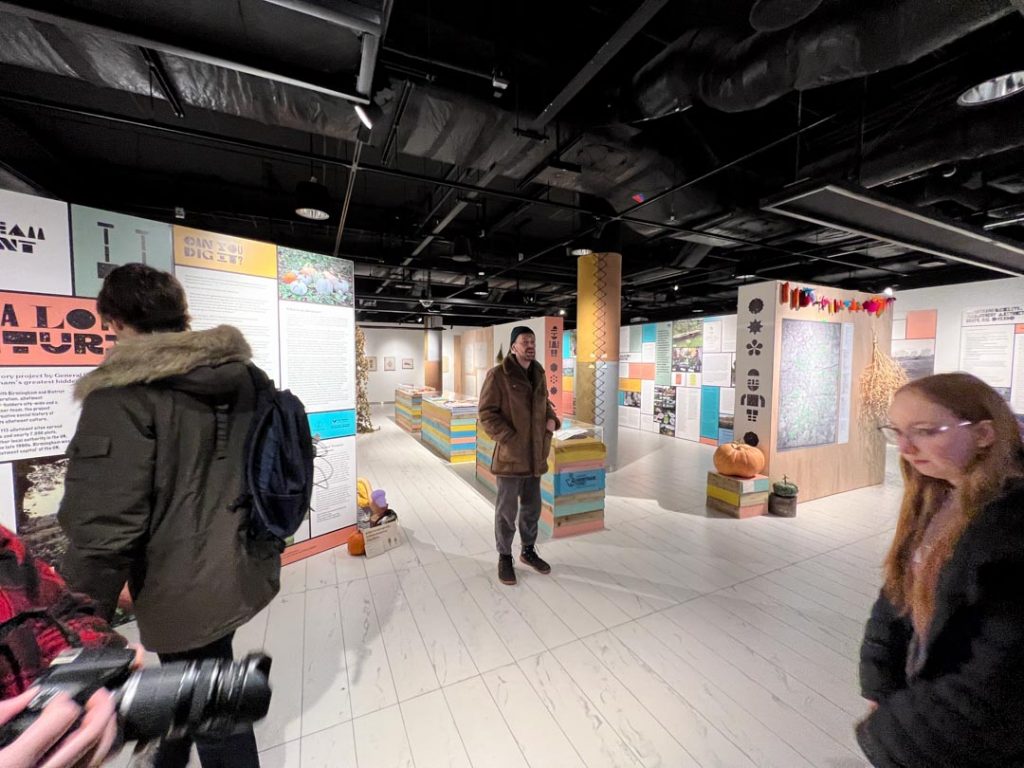
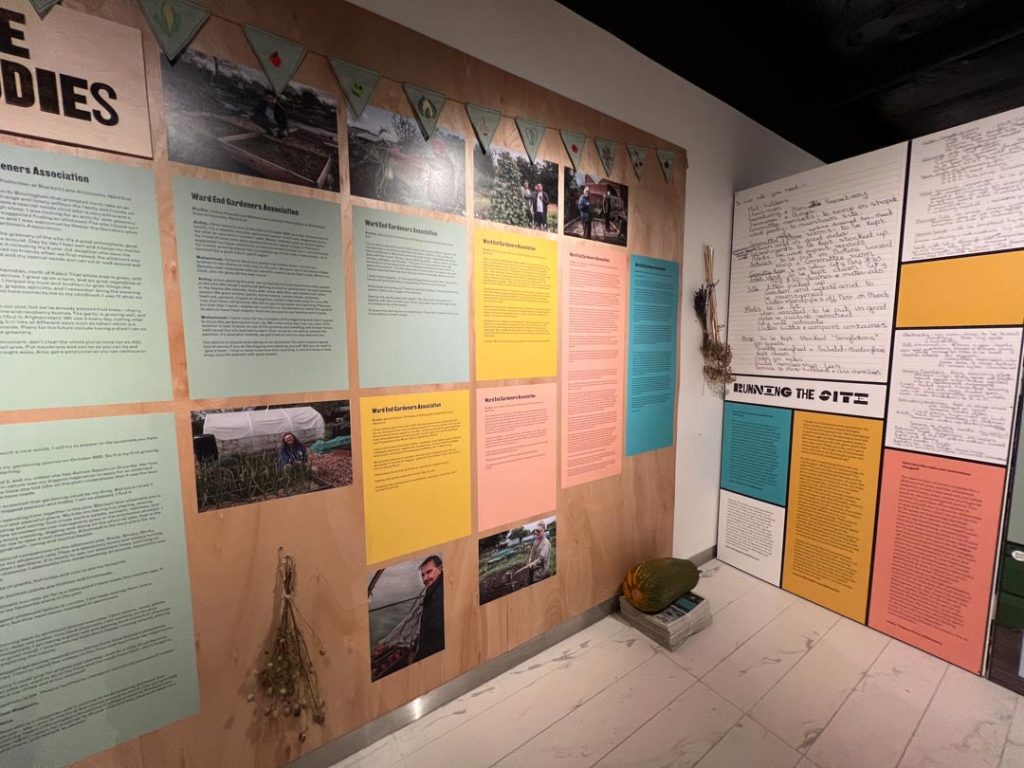
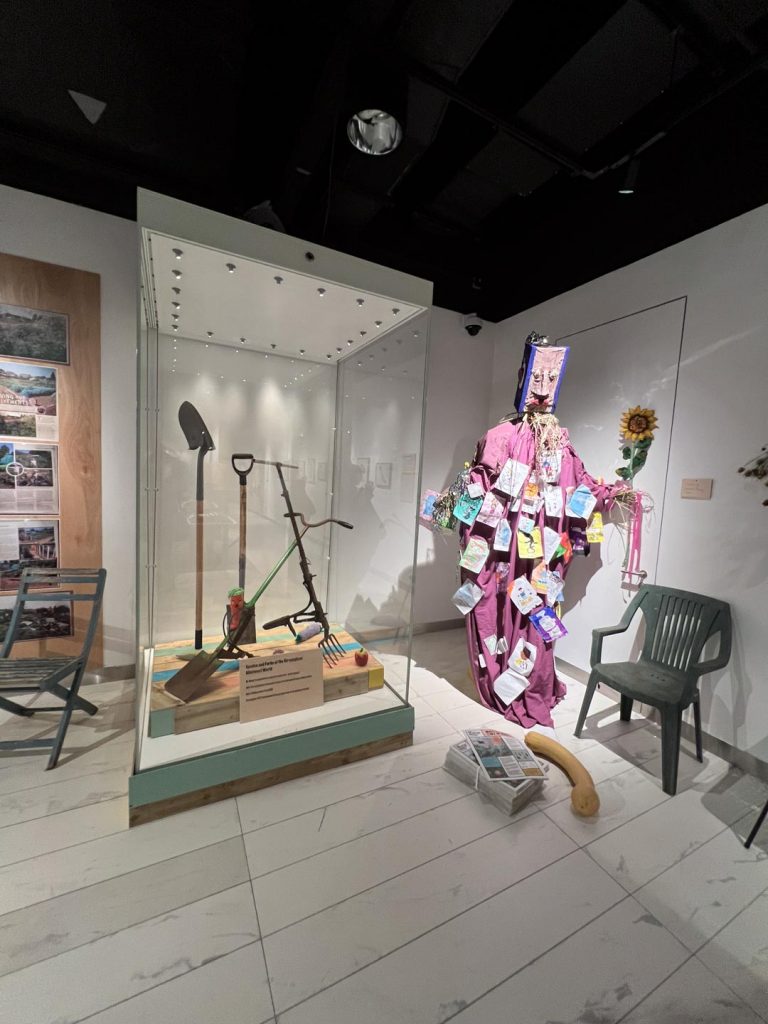
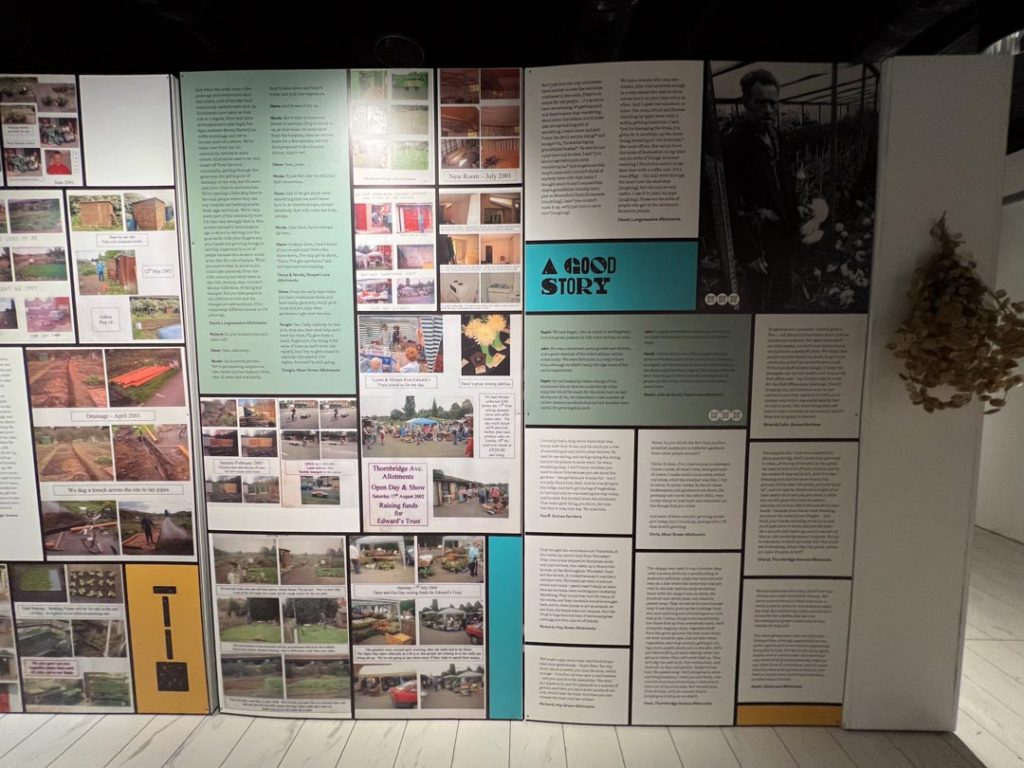
Reading the text, and there was a large amount of it to be read, it explained there are nearly 7000 plots being used across 113 allotment sites in Birmingham. It’s no surprise then to read all of the testimonies of the people involved in managing them and growing not only fresh produce, but growing themselves and their fellow humans. There are moving stories about how allotments are used to help people with anxiety out into the open, disabled people to get out and do something physically and mentally stimulating, elderly people with nothing to look forward to now being able to look forward to their next harvest.
One quote that appears in the accompanying newspaper style brochure is from Ish at the Lime Tree Road Allotments who said “and my motto is from the soil to the soul”, implying that the connection is somehow spiritual between the gardner and the land, that tending to the earth itself results in oneself being tended to. Quite an idea, and one that is a common theme through many of the blocks of text included alongside photos or exhibits.
There are also sculptures, embroidery pieces, applique, historical documents, paintings, and all manner of nostalgia inducing pieces of work. All accompanied by huge pumpkins, gourdes, marrows and other veggies. I wasn’t sure if the veg was fresh or fibreglass but I didn’t touch it like a good boy..
The applique pieces were based on fictional fruit and veg and were wonderful to see how the imaginations of the kids involved had dreamed up some of the most inventive new species, only for them to be captured and embellished with sparkling thread.
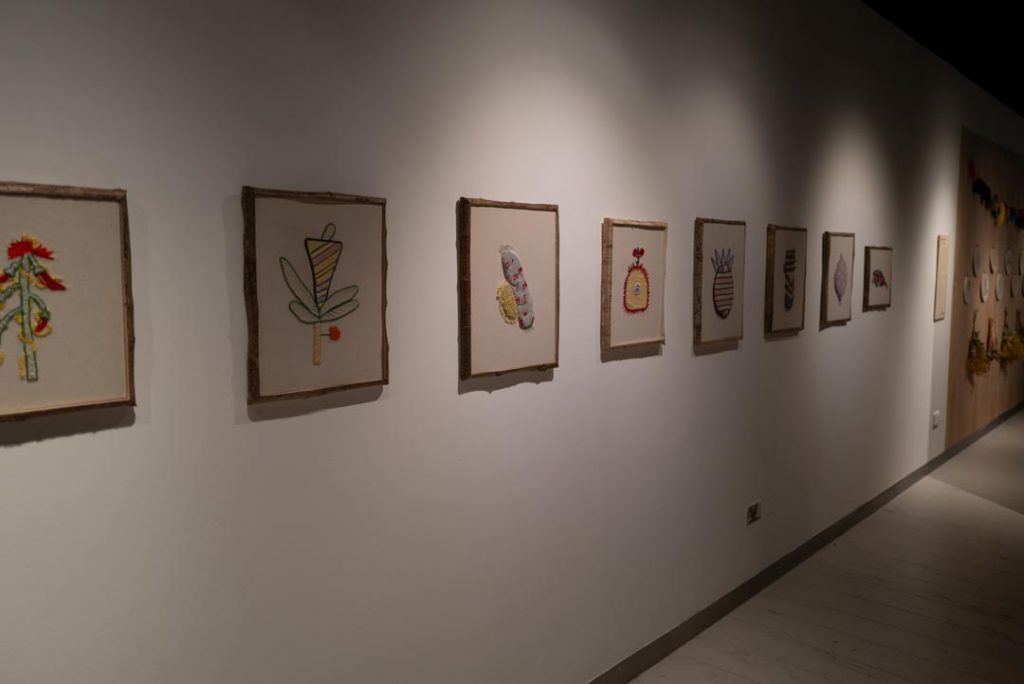
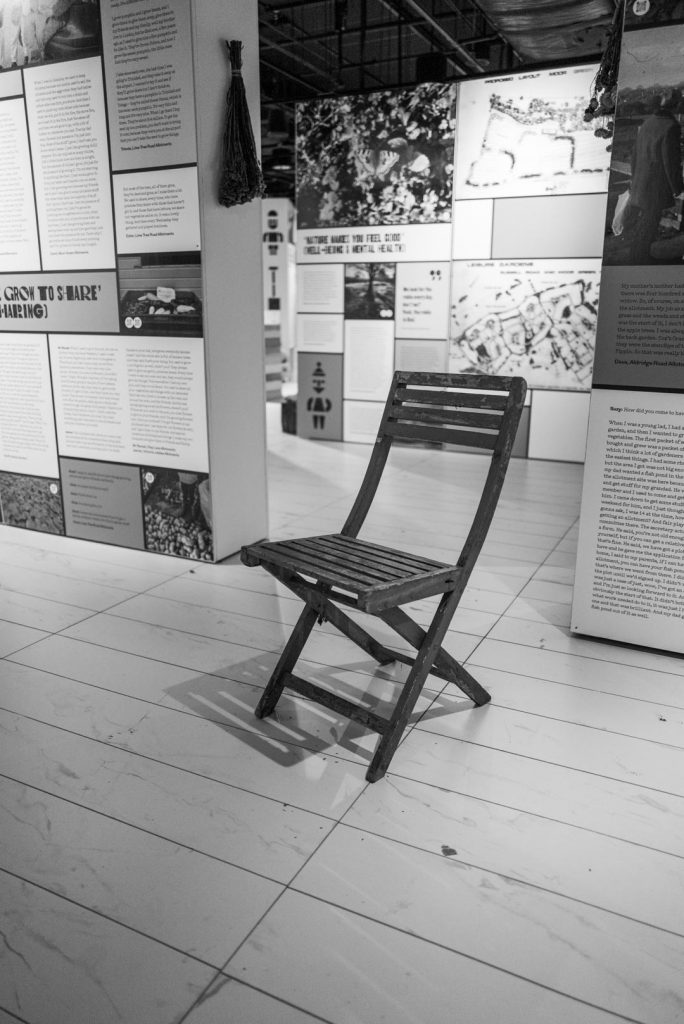
Whilst the photographs and text told a great story of the importance of allotments in Birmingham, I found the exhibition to be too much to take in. If you were going to read everything you’d be there for days I’d imagine. If you wanted to you could listen to audio clips too and these are available at the projects website. Here
Allotments don’t interest me greatly, and as much as it brought back some lovely memories of spending time with Grandad and Norn at their allotment, I found that I was disconnected from the subject matter. The photos were interesting to look at but mostly all amateur snapshot style photographs. It must be noted that I wasn’t expecting anything else but I didn’t enjoy the subject matter as others did so I probably wasn’t engaged with it as much.
IKON Imposter
Once we’d had around twenty minutes in the library we made our way over to the Ikon gallery to view Dean Kelland’s exhibition Imposter Syndrome, which features a lot of work from his time as resident artist at HMP Grendon. Once we managed to get inside, by deceiving the reception desk that we weren’t all part of the Wolverhampton Uni group, we made our way up to the second floor to the exhibition.

Dean is a former lecturer at the Uni of Wolves School Of Art and we know him and his work from talks about HMP Grendon as well as his instagram feed etc.
Kelland’s sketchbooks were made use of impressively along with other documents, notes and printouts, magazine cutouts etc. As we walk into the gallery for this exhibition we are greeted by Man and Boy: Hunky Version (2023), a huge print cutout of Elvis in a western movie, with the mask of a David Bowie person stuck on the top. `this is an enlargement from a page in his sketchbook and is impressive. Only after I’d looked at it a few times did I notice the gun in Elvis’ hand was blurred out, possibly to remove the weapon, as I don’t know if it would be allowed in the prison like this.
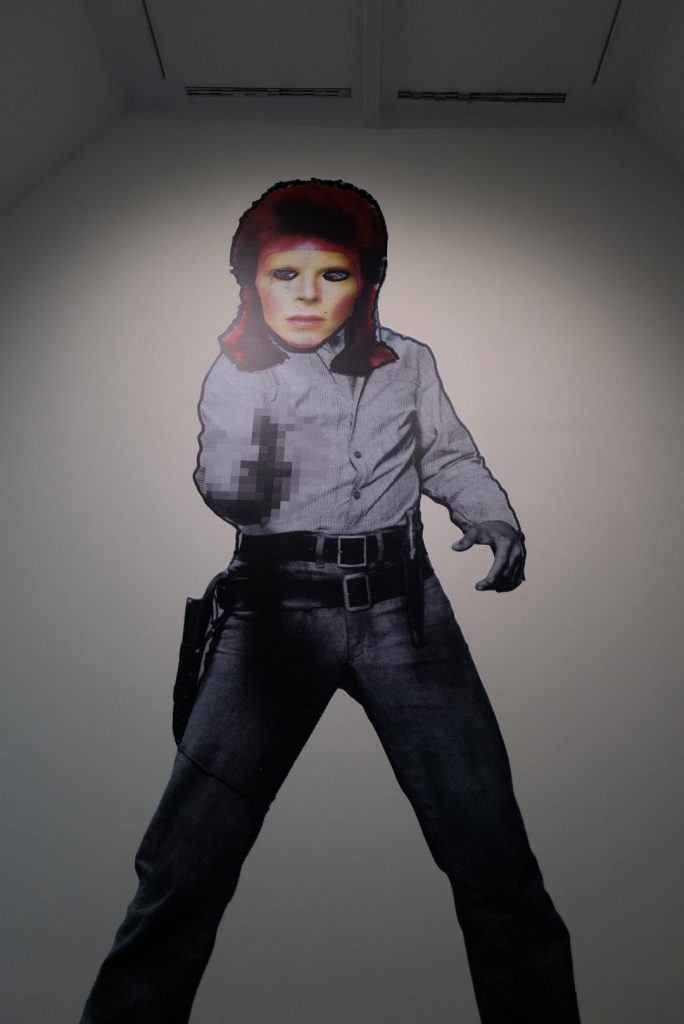
In the same rooms is So the Days Float Through My Eyes (2023) in which a group of prisoners stand in front of a wall, in what the exhibition guide calls a “retro-futurist” setting. The men all wear masks of David Bowies face and hold up song lyrics made famous in Bowie songs. It’s at this point that I notice the masks are a constant theme of the first two pieces, and I remember Dean once telling us that any photos or videos of prisoners is prohibited if it captures their faces. This is most likely the reason they wear masks, but then going into the remainder of the exhibition, masks are everywhere.
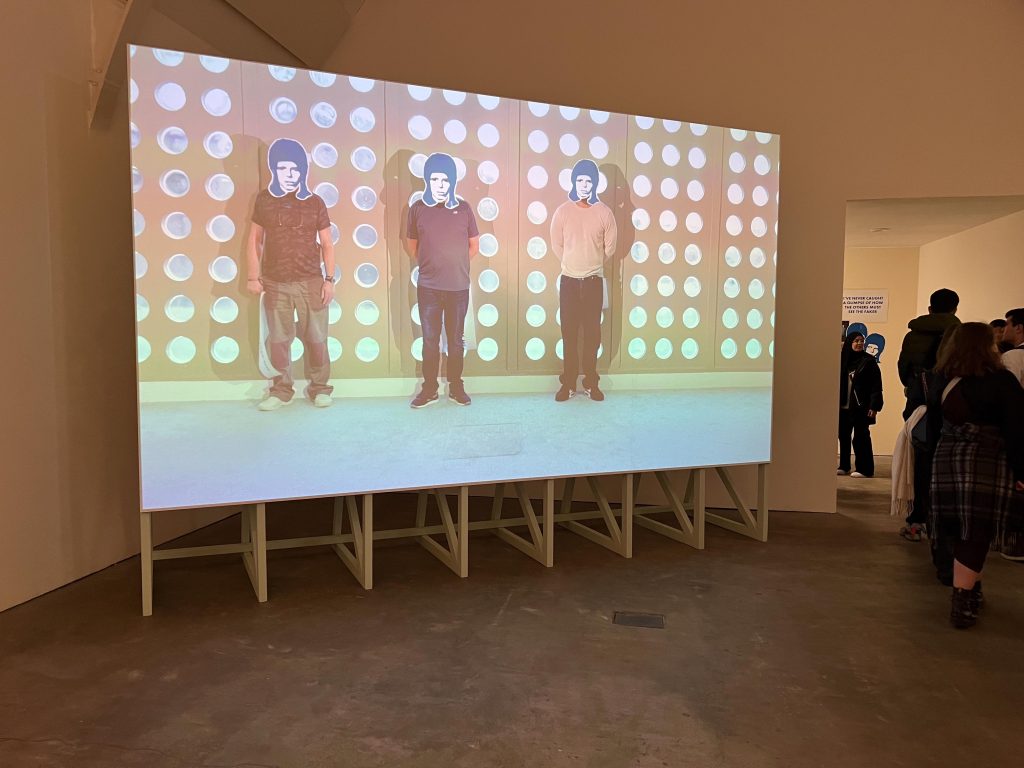
Into the next room and we see, Absolute Beginners (2022), a black circular structure which features a backlit projection of prisoners, standing in front of a mirror, wearing their prison issue clothes and a blank mask. One of the exhibition guides in the space called it a “neutral mask” as it is blank and featureless. It gave me the impression that the wearer was unable to ass through the mirror like a door into the place where they longed to be and felt a faceless piece of the whole penal system. The exhibition guide explains “Neutral masks are a device used in theatre training and psychotherapy to facilitate the wearer to experience the present moment, unaffected by
their past and future”
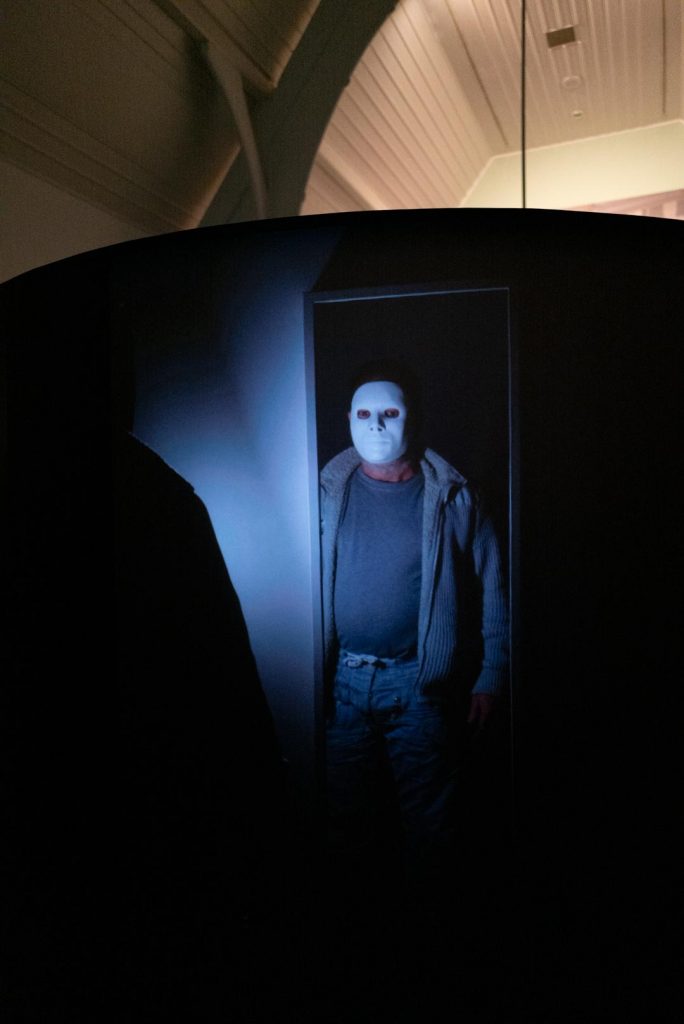
This is a tricky subject to deal with for Kelland, all of these prisoners have been found guilty of a crime and sentenced, so the artist needs to be mindful of the victims and their feelings. On the Ikon Gallery website the statement “Ikon has engaged with meaningful discussions with Victim Support to inform the development of Dean Kelland’s exhibition.” lets people know that this has been carefully considered and adjustments made to ensure that further harm to victims is averted.
Another video installation called Walk a Mile in My Shoes (2022) features a prisoner walking toward the camera in a featureless and monotonous corridor within the prison. Eerily the person wears an Elvis Presley mask and walks, stumbles and even dances their way towards you, the viewer. It’s stuff of nightmares and the masks used again, in this case Presley, were chosen by the inmates to represent the “Perfect Man”. There were numerous references to pop culture icons, throughout the show ranging from Buster Keaton to Bob Mortimer, but most who featured in the sketchbook or works of art on walls had the eyes removed to use them as masks. I found this interesting but Ieve, my coursemate, found it extremely disturbing.
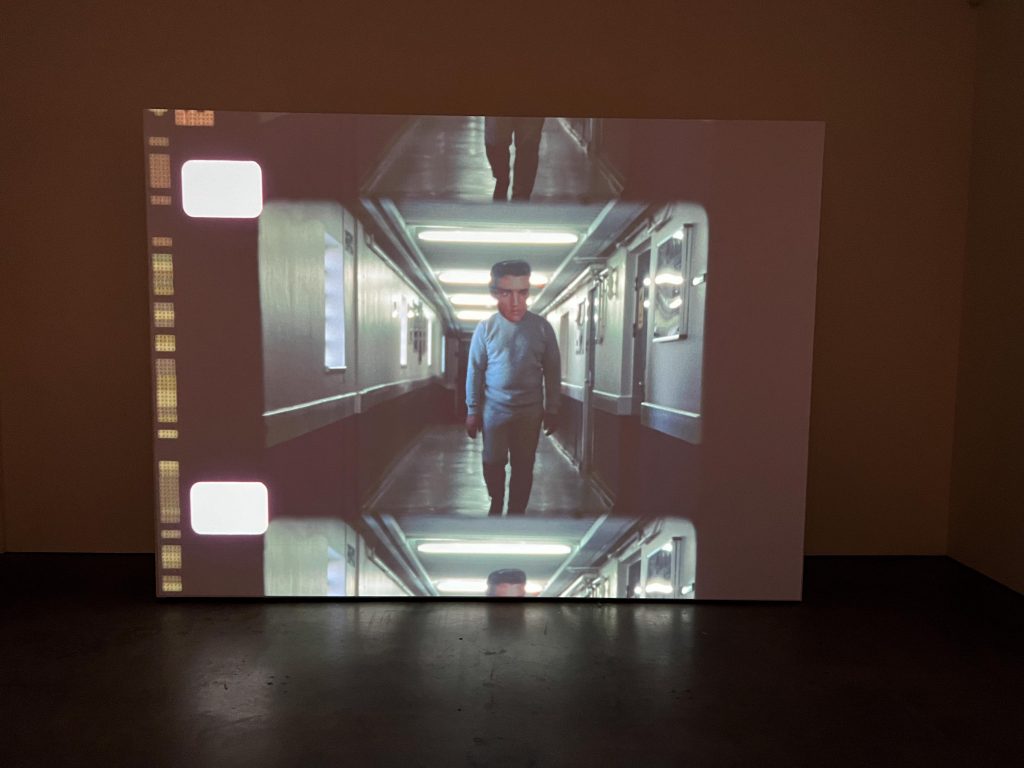
Overall I enjoyed this exhibition far more than the Allotment project as it felt more engaging, creepy, spooky, and dangerous. The masked men were faceless and the ambiguity of the Bowie masks along with the Presley masks left me feeling very uneasy. It was however, good to see that the prison system appears to have some parts that are working to reduce the reoffending rates of prisoners. The Guardian newspaper have an article on this subject which highlights Grendon, and states that prisoners who complete the 18 month therapy course at Grendon are 20-25% less likely to reoffend than those at other facilities. Impressive.
I liked Kelland’s sketchbooks and methods of working, I also liked that he will insert himself into the work without concern for his own image. It’s a thought provoking exhibition and I’d recommend it to others to go and take a look.
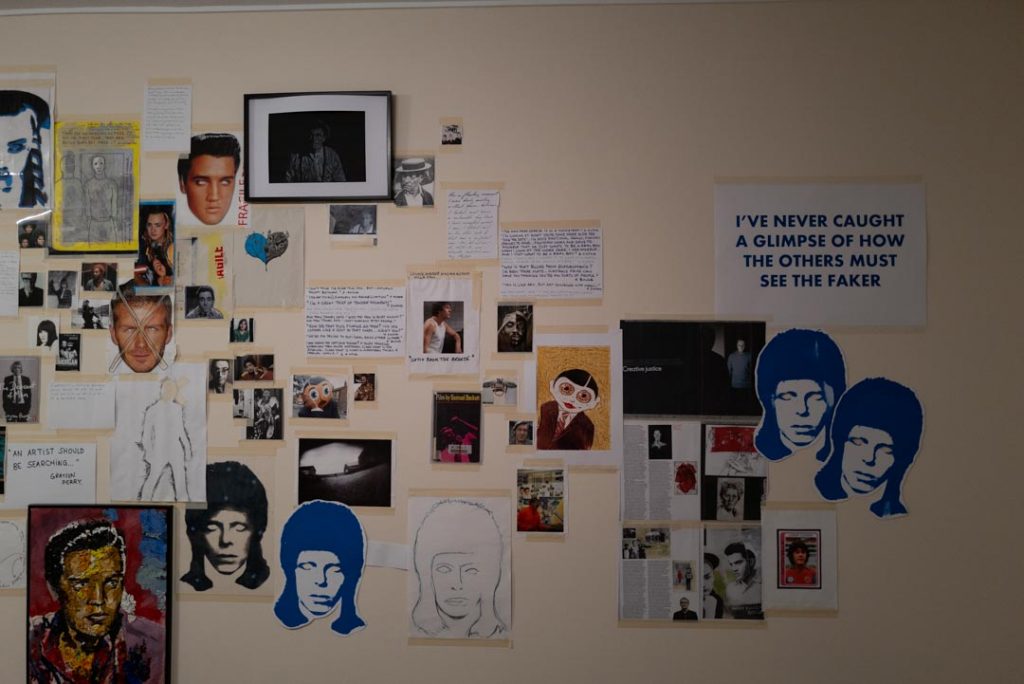
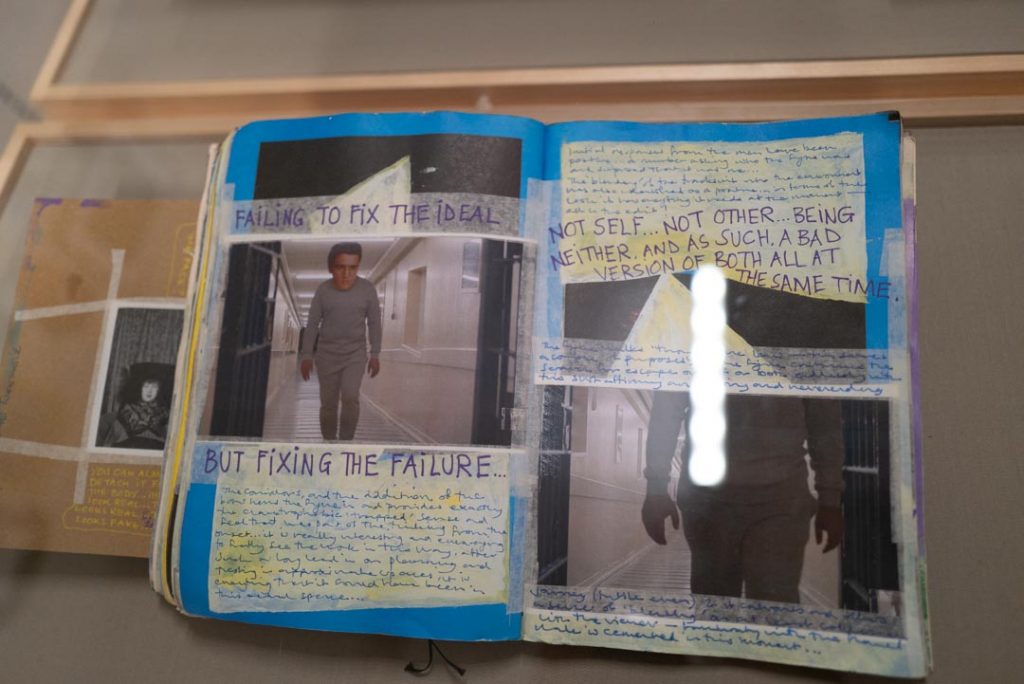
Calling
After Kelland’s exhibition was examined by myself, Noah and Ieva, we headed down to the next floor to view Mali Morris’ exhibition “Calling” Morris paints abstracts and uses special techniques to “clear paint from the canvas” to change the space that she shares with the viewer. There is a circular motif that appears in most of the work, either as obvious circles or less obvious circular shapes made of straight lines.
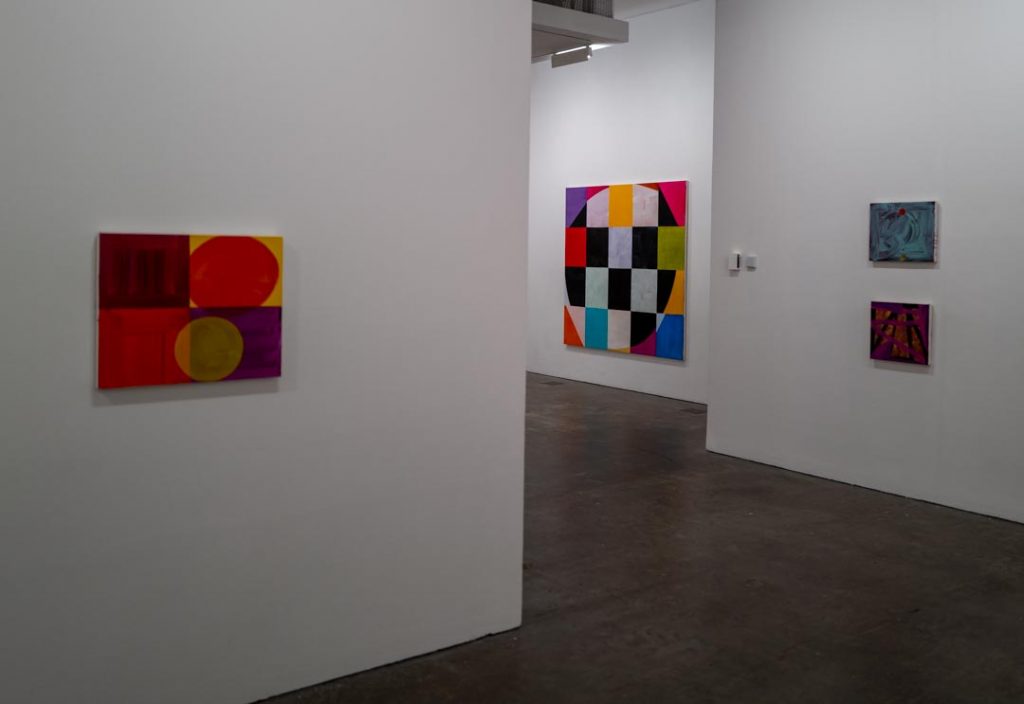
I enjoyed this exhibition as it was a bit of a break from the hustle and bustle of the previous two exhibitions and felt more relaxed. Her earlier works, according to the Exhibition Guide, “belongs to a painterly tradition including Abstract Expressionists” but the “The paintings in this exhibition carefully deconstruct this tradition,” The bright blocks of colour and geometric lines and circles are something that please me but I know little about abstract expressionism. I will go away and learn a little more about it as a result of Morris’ works today.
After some hanging around on the stairs to capture shoes and feet through the frosted glass of the stair levels we headed off to the next destination.
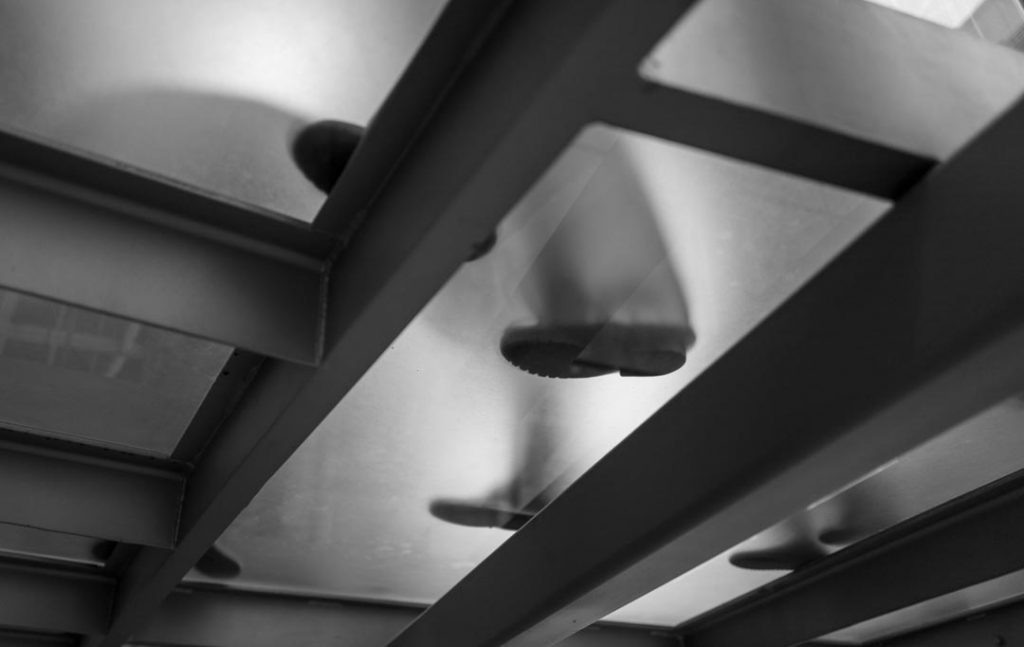
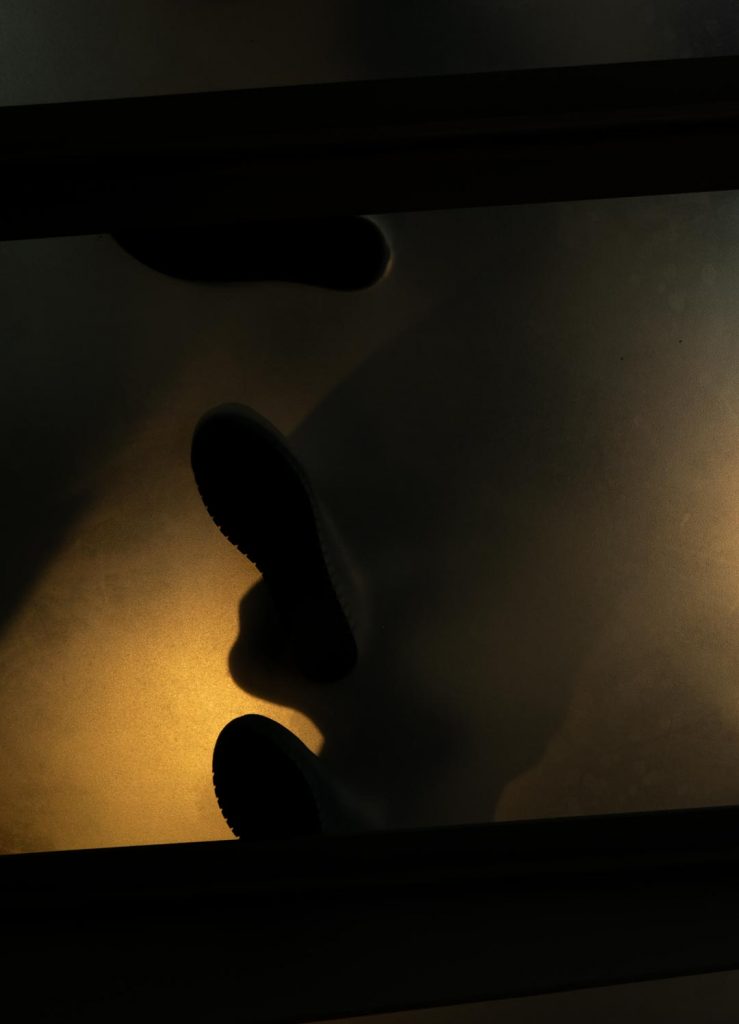
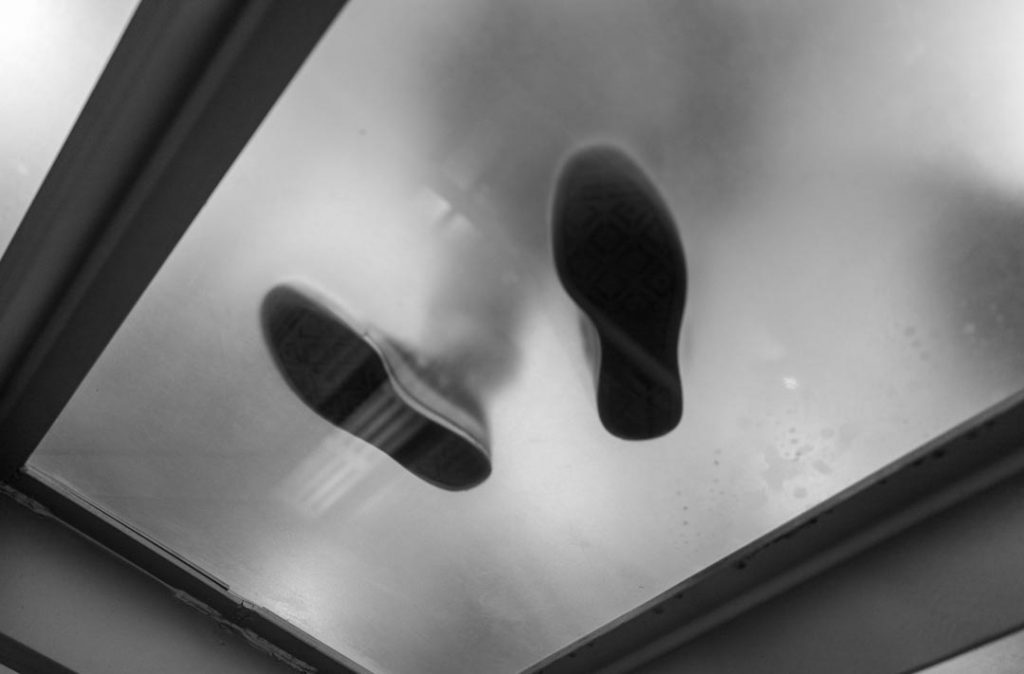
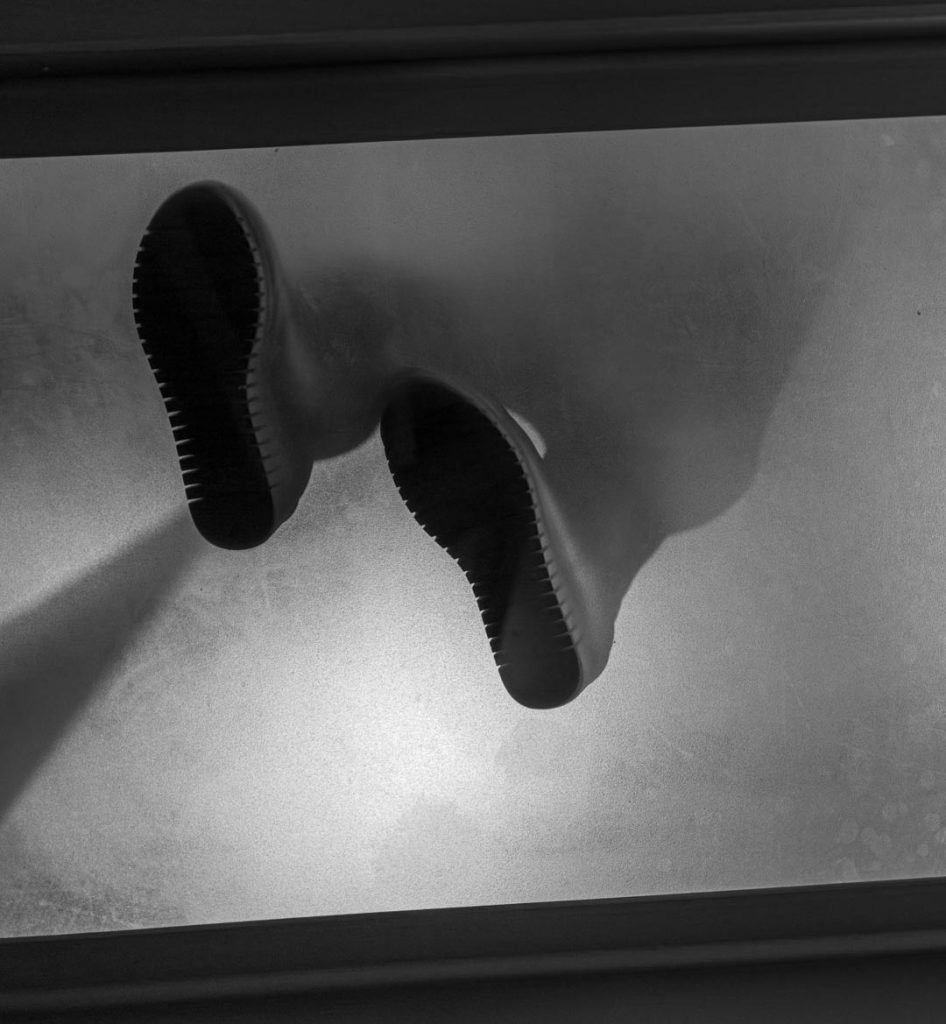
Eastside Projects
Over in Digbeth is a free public gallery called Eastside Projects which is a wonderful space and the people there are very friendly and open. The space looks like an industrial unit with high roof and a couple of rooms off the main gallery. Today it is full of an exhibition; “dankEconogy1_ALIENVillage” by Sahjan Kooner with Sophie Chapman, Gary Zhexi Zhang, The Villagers and Manjit Kooner.
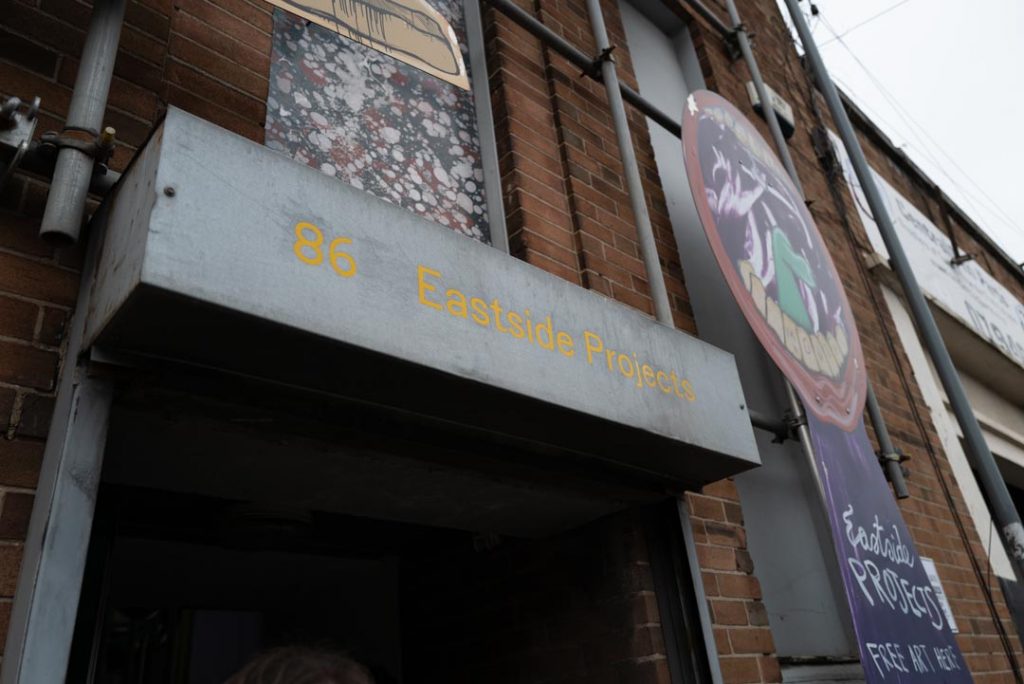
According to the artist themself “dankEconogy1_ALIENVillage is a speculative commons. It is a vessel that will ‘visit’ sites and contaminate them forever.”
Ruth Claxton gave us a brief insight into the studio/gallery space and also the work that they do for theo whole of the Birmingham area artists. She then introduced the artist, Sahjan Kooner, who gave us an artist’s talk about their practice and the contents of this particular exhibition.
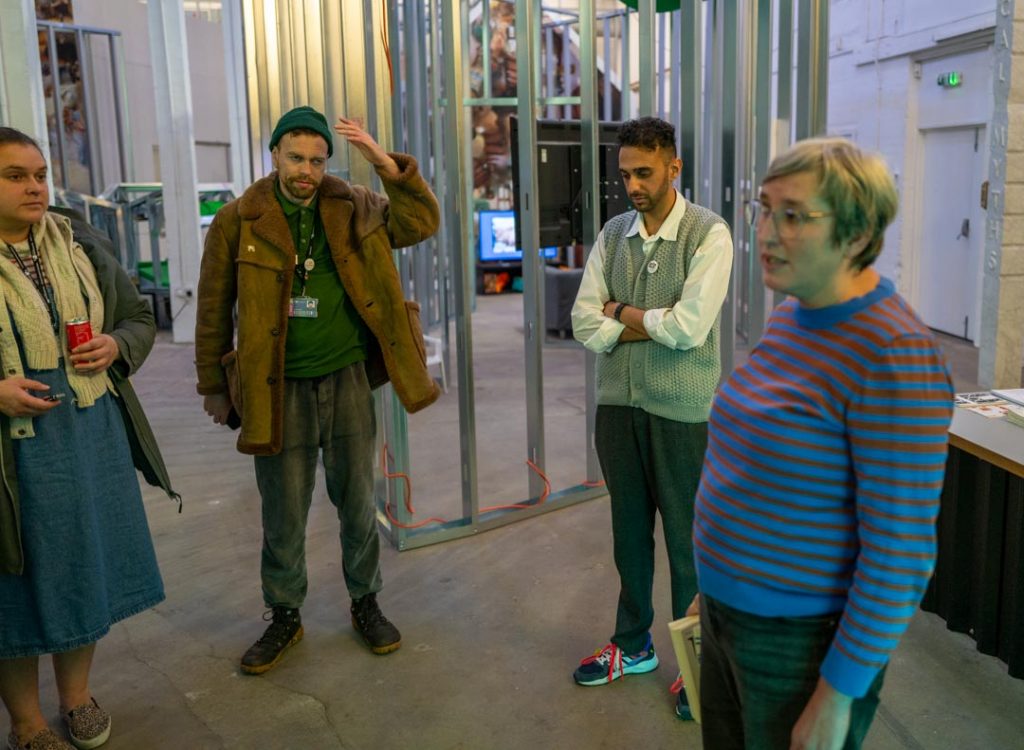
It consists of rooms made from the hidden parts of internal walls, the metal structure without any plasterboard etc. In the exhibition brochure we have two pages of why the skeleton infrastructure was created. In each of the rooms are different parts of Sahjan’s story that takes us from their childhood in the Punjab, failing in the creation of a killer chatbot app, all the way through to visiting outer space in a show consisting of multimedia presentations. There are video presentations on large screens, small raspberry pi screens and even a section where you can lie down in a cross of four beds, to play a video game above your face.

One of the rooms at the end of the story consists of photographs of the artists past life or family and friends photos stuck on the underside of a glass container acting like a petri dish and allowing growth of bacteria and who knows what else.
In the exhibition programme, which in the manga tradition is printed to be read from back to front, Sahjan is quoted “I want you to come and discover the traces of love, longing and possibility that make life possible.” I get the overall feeling from this piece that it is a love letter to a less complicated time when the artist played in the streets with friends, dressing up as space explorers, learning how to navigate through life post academia and then looking back into the family archives to check one’s own self worth against the generations that have come before. This feels relevant to me as it sounds familiar.
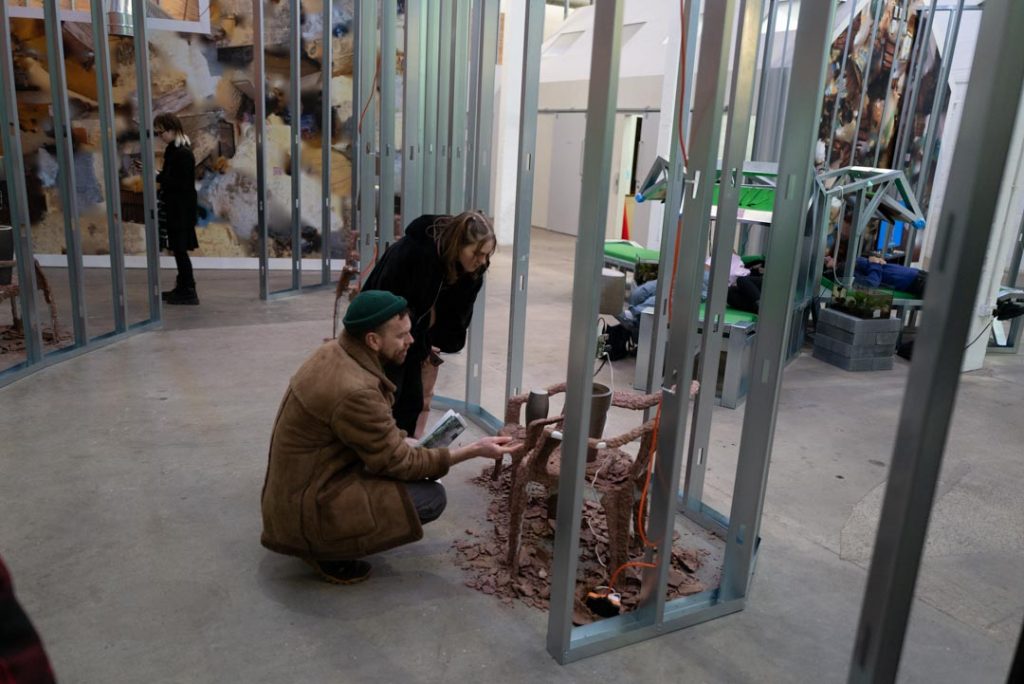

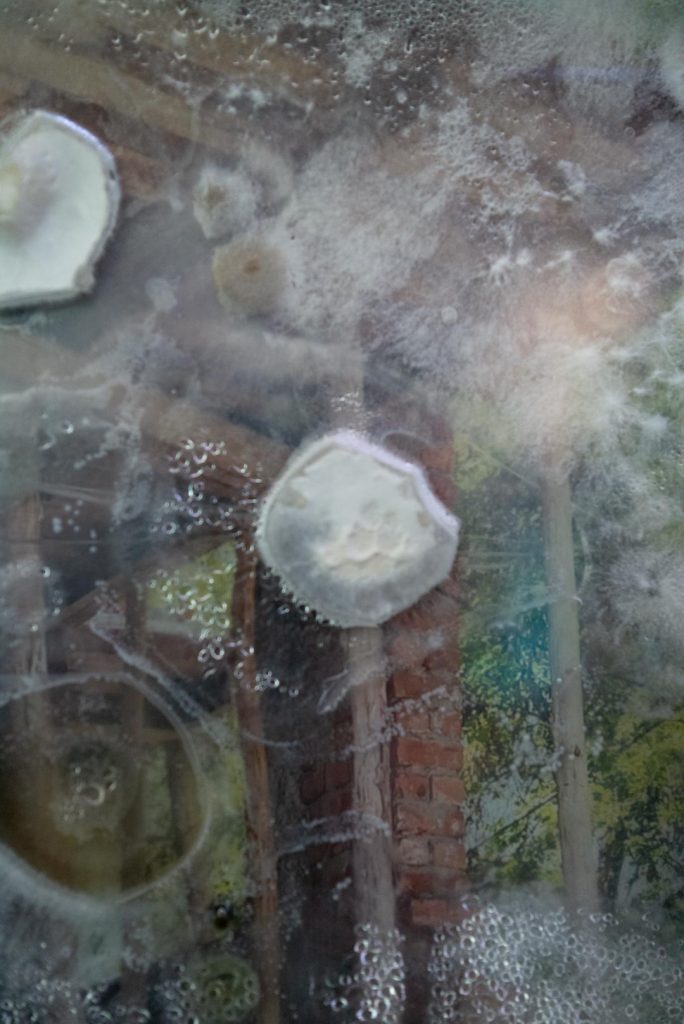
Aside from this life journey though, I struggled with the exhibition. I had difficulty getting my head around it all and wasn’t overly moved by any of it. Whereas I could relate to teh allotment project mentioned earlier, I felt that this was completely alien to me. It might possibly be by design, after all it does have ALIENvillage in the title. There was also a soundscape in the room that I found grating and uncomfortable. The sound emanated from some vents that Sahjan uses as a link to the game Metal Gear Solid, that I used to play back in the day, but I didn’t see that it all fitted together nicely for me. I did see many of my colleagues from the university who were really engaging with it but I think these were mostly the fine art students. Perhaps that is the disconnect for me, perhaps there just wasn’t enough photography.
U & I
Before we left Eastside Projects though we popped into the gallery off the side and had a look at the film being screened in which we see two women walking through a woodland walk. We don’t see their faces and combined with the clothing and distance from the camera it makes it difficult to work out their ages and relationship.

On a side screen though, we see the process of a wig being manufactured from the initial head measuring to the pulling of individual strands through the cap, then it’s dyed red and styled. But whose is it? Is it on the head of one of the women in the video?
This is the work of Natasha MacVoy and is called “U & I” It not only consists of the two videos but also some sculpture adorning the walls and a couple of mannequin heads with parts of tracksuit tops fitted to them. Reading the entry on the website we read that this was about providing a support structure for her children who are neurodivergent and not getting the required support from the relevant support providers.
We read that the woman in the video is an actor walking alongside the artist, wearing a wig made of the artists own hair and mimicking her every move, gesture and aura. The walks are in places the artist took her twins during the struggles to get them “re-engaged with learning”.
Whilst I enjoyed the drone camera footage of walking behind these two women, it wasn’t immediately obvious what was happening and why. It’s the exhibition guide that fills in the blanks in terms of the context and contents. The guide doesn’t elaborate on the clothes in the corner of the room but I’d hazard a guess that it is a representation of her two twins.
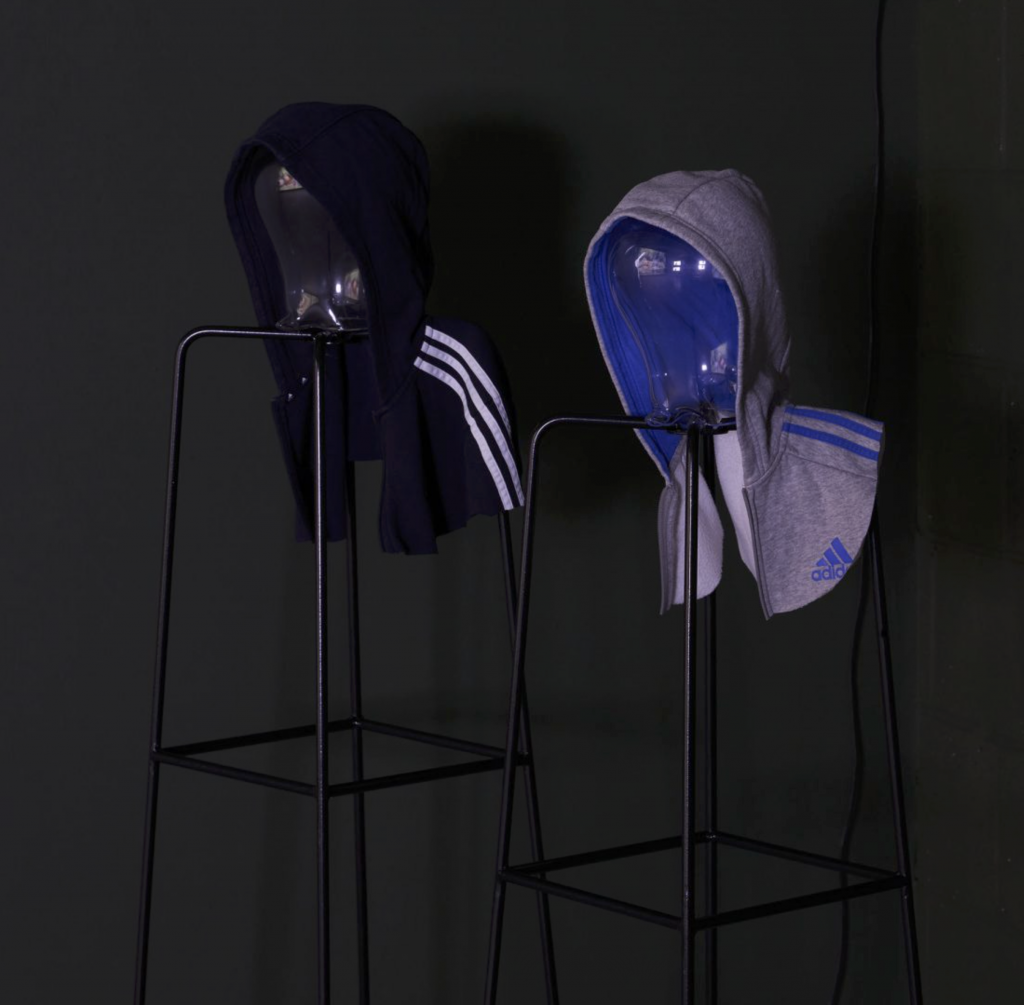
This part of the exhibition was the most accessible to me, compared to the dankEconogy1_ALIENVillage work. Like that work though, there was also a disconcerting soundtrack to the videos in the room, a sort of disharmonious stringed musical instrument being plucked and caught to make some odd sounds.
Minerva Works
From Eastside Projects we walked on to the Minerva Works where we split once more into two groups, the first would go into Grand Union and the second into Centrala, then switch around.
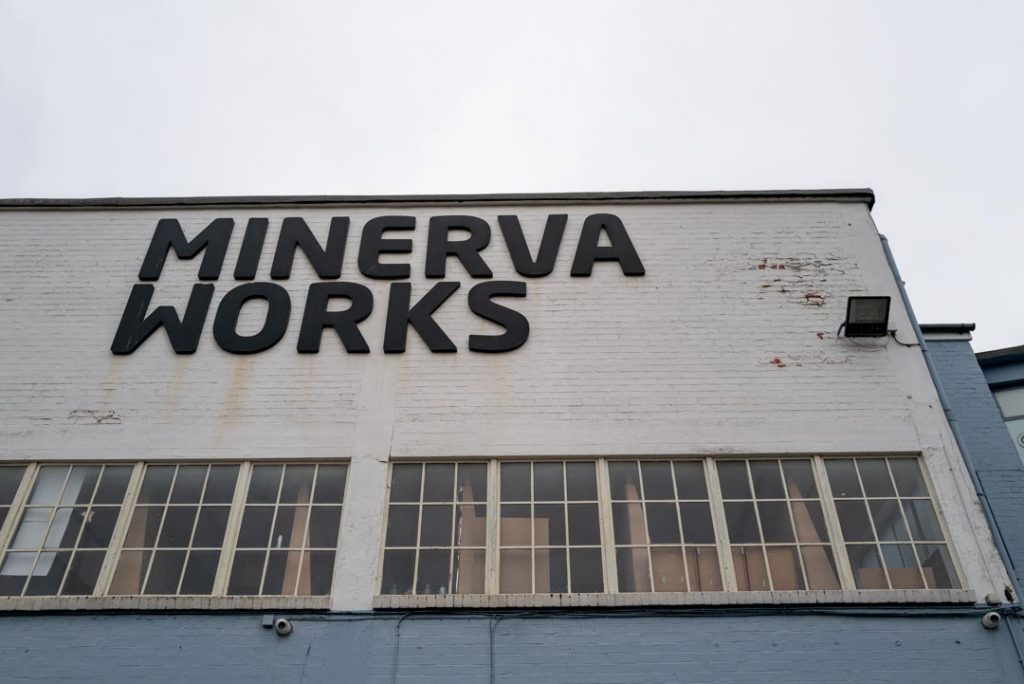
According to Brittanica.com “Minerva, in Roman religion, the goddess of handicrafts, the professions, the arts, and, later, war” seems strange that handicrafts and arts could lead to war as my experience is that arts are often a response to war and it feels contradictory to have a goddess of both.
We headed up the stairs into Grand Union and saw a few of the artists and people in the area before going into the main exhibition space where a large video screen was on and displaying the piece of work called “A Bedroom For Everyone” by Ed Webb-Ingall. The video displayed an animation in what I would describe as a Charlie and Lola style. It was simplistic made up of moving parts of characters with no moving facial features but this didn’t detract from the impact of each of the people portrayed. The people in the film are discussing the housing crisis, renters issues and many other topics that means people in the direst of straits are the same who are most likely to be impacted by faceless organisations and landlords treating them as an inconvenience.
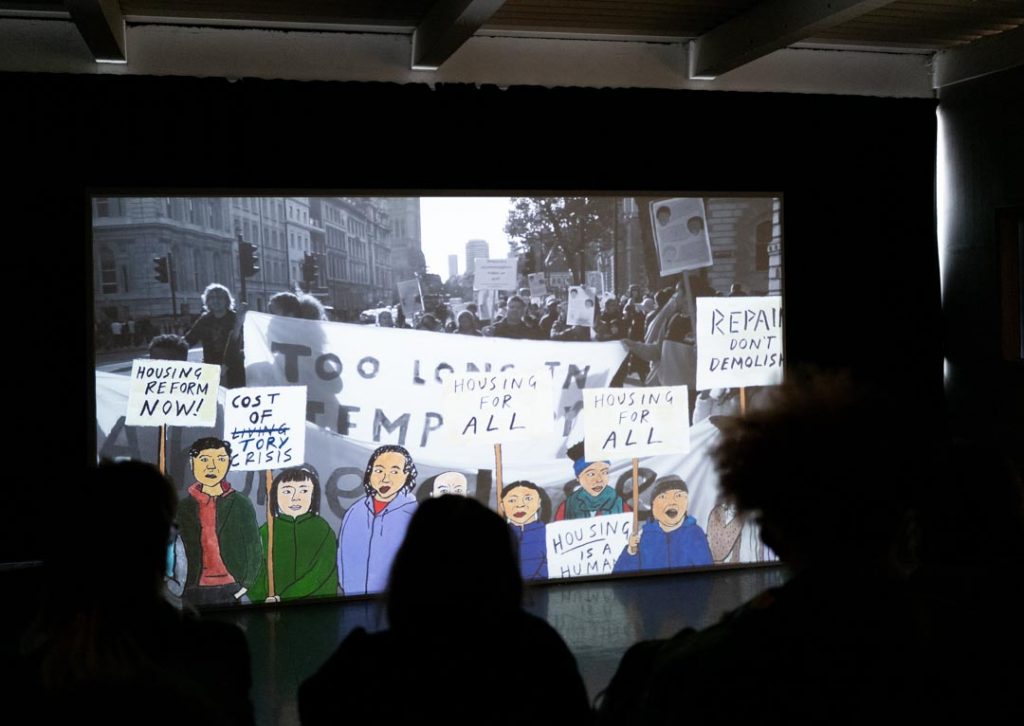
It touched on many points that affect a large part of the people resident in the UK today and got over the message well and in a reasoned manner. It promoted the benefits of working together to take action and help each other to overcome some of the obstacles these landlord organisations have in place which make it less accessible to have a meaningful discussion with them.
Also in this exhibition space were a few posters on the wall for a woman reaching her goal of becoming a new councillor in her area along with some protest placards featuring slogans from the main video.

In the room was also another small CRT Television set showing a video from 1987 by Leeds Animation Workshop called “Home and Dry?” which was an animated short film of 8 minutes detailing the plight of four women who come to realise that they have all experienced homelessness without having to sleep out on the street. The Leeds Animation Workshop website describes it; “The film analyses the inadequacies of housing policies and examines the political thinking that lies behind them.” We didn’t have time to watch this video as we were moving on but there is an extract available to watch on the internet which is worth a few minutes.

Once we’d had a talk from Hannah Wallis, Programme Director, at Grand Union and arranged to switch over the groups we descended the steps and headed to Centrala, around the corner.
Centrala
Upstairs in Centrala the exhibition “Homeland” by Paulina Korobkiewicz was shown around the room along with a wall of photos by the Central European Photography Club.

Homeland addresses “themes of political identity, belonging, memory and representation among migrant communities in West Bromwich and Hyson Green, with a specific focus, but not limited to, Polish migrant communities.”
There are numerous photographs of areas that the artist visited to make this project, showing individual features that go to make up a whole picture of the region. Shops, churches, portraits and even photos of food dishes all capture the essence of the area in front of the camera to help us understand the life of migrants who have moved into this part of the country. Whilst it doesn’t complete our knowledge it is a good insight into the lives of the people being discussed and the photographs are very factual and represent the real world.
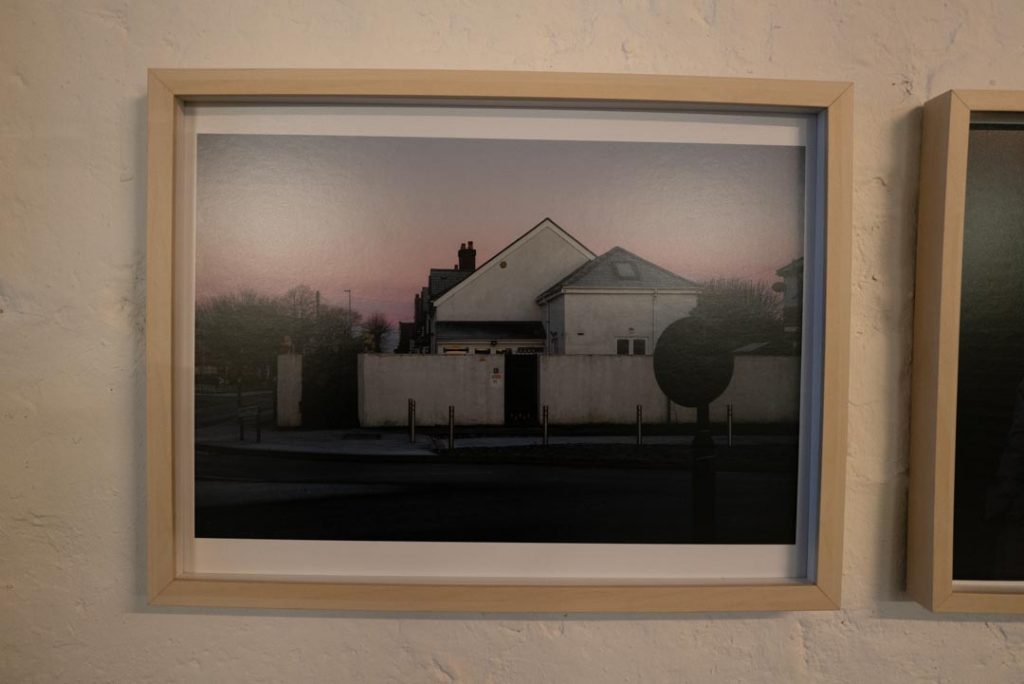
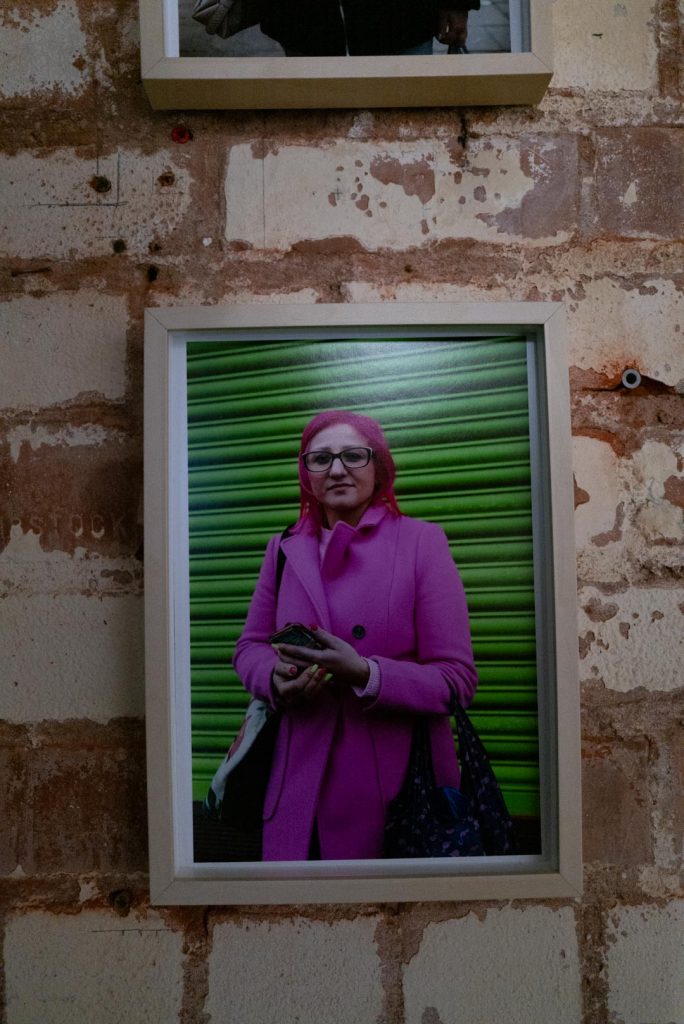
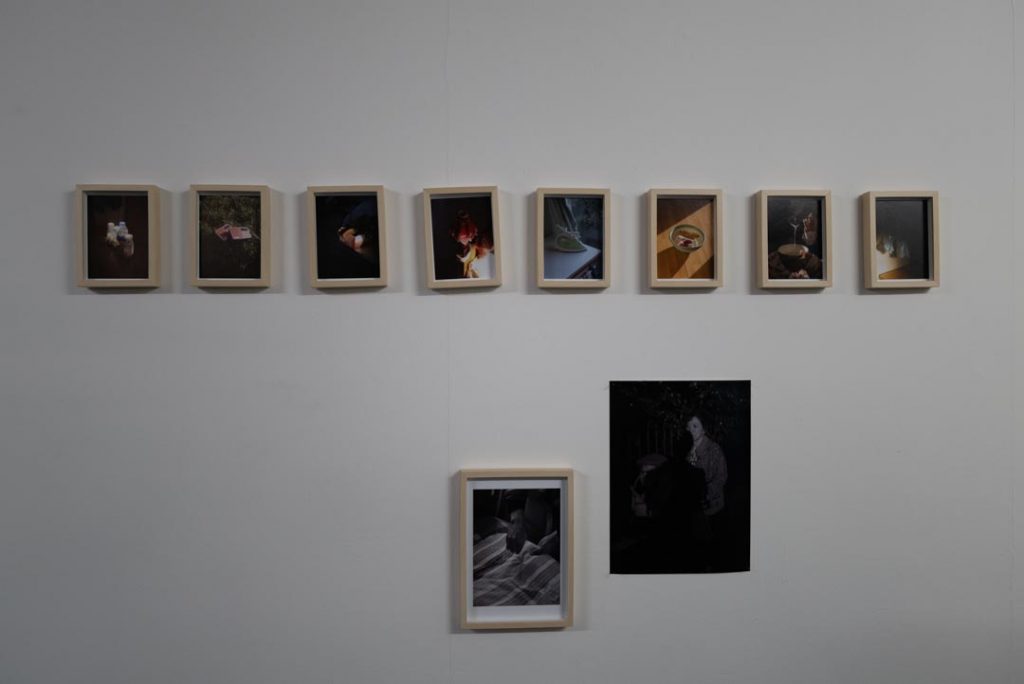
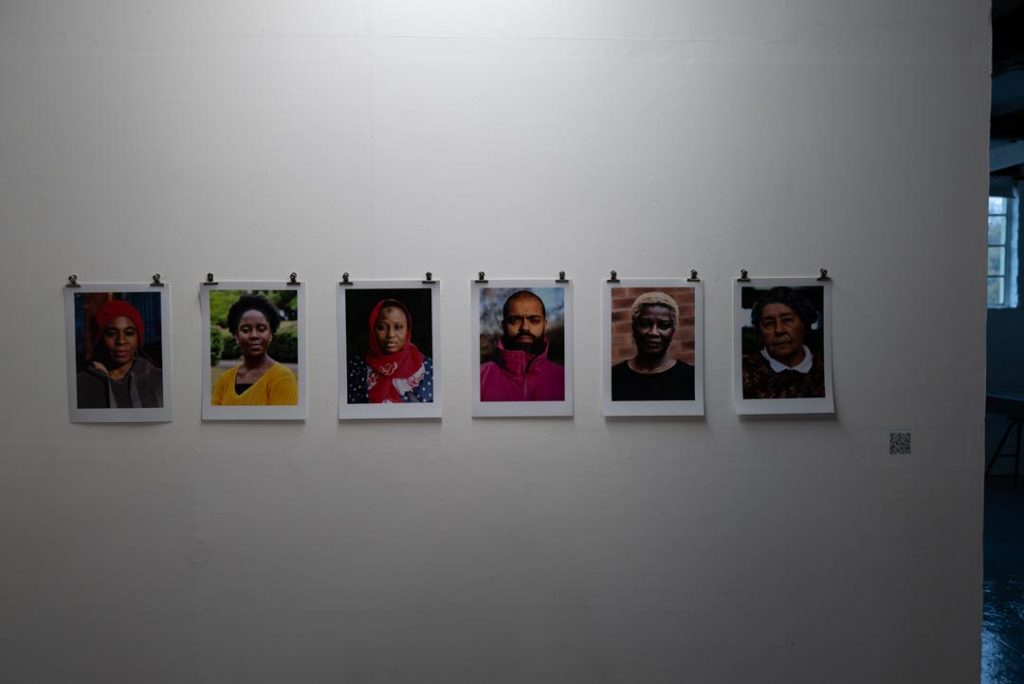
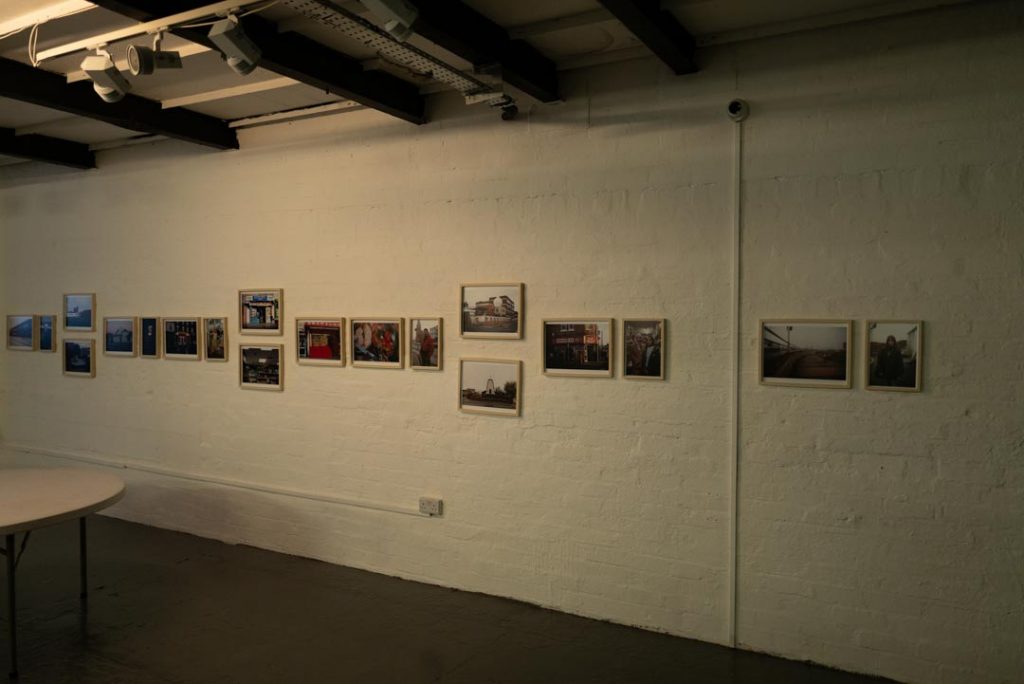
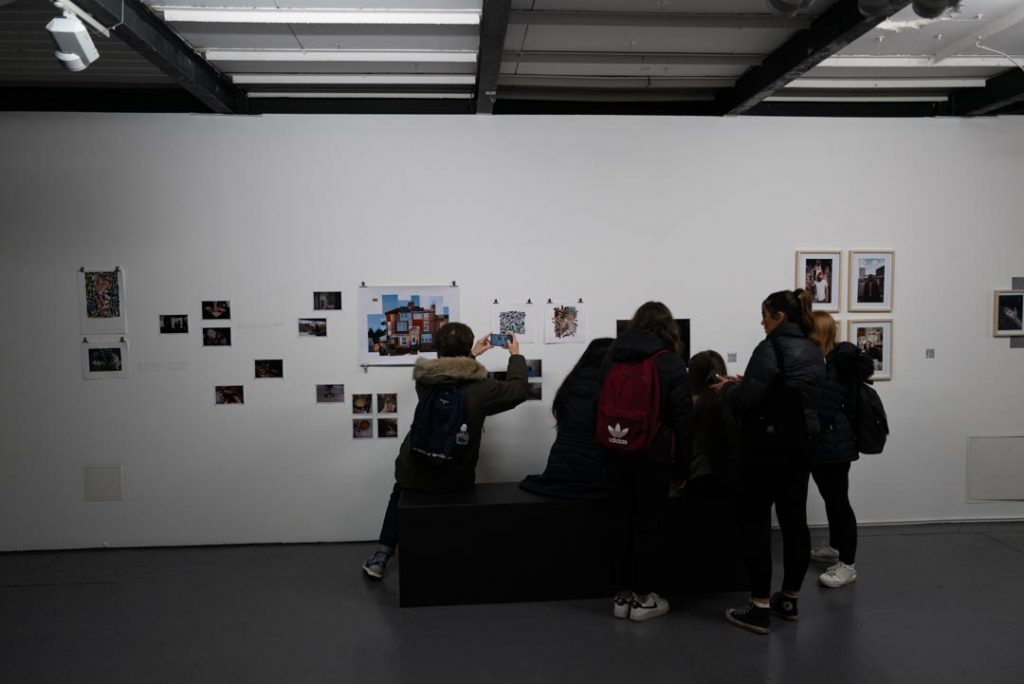
The photos on the walls were in box frames with no glass/perspex and sat at the rear of the frames, they were on lustre/satin finish style paper. The colours were muted in many of the images showing a lack of post-processing that also lends the feeling of documentary realism. There were no labels or titles on any of the photographs in Korobkiewicz’s collection leading us to read into them whatever we thought, based upon our own expectations or experiences of immigration and local communities.
There was also a central structure made of wooden battens screwed and hinged together like a privacy screen with no fabric on it. This was used to host a number of photos also that seemed to be the central images of the exhibition. I was looking at this thinking it might be a good method of creating more space in the Eagle Works when we carry out our exhibition. Especially if the space on walls/windows becomes a limiting factor.
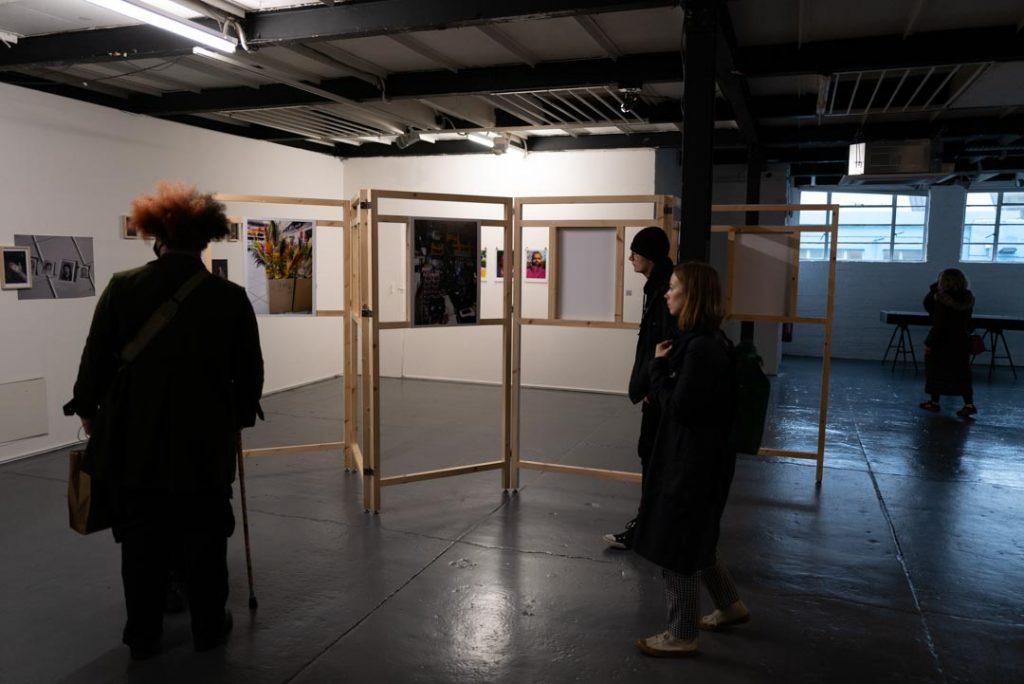
Interestingly, there were also a couple of pieces of art that consisted of photographs that had been woven together, much as I had done in my year long project last year. It appeared that an artist had merged together two images, one of an old family photo style picture with a more recent one. Possibly comparing the two children in the images, maybe it was the artist as a child being compared to a photo of their own child recently.
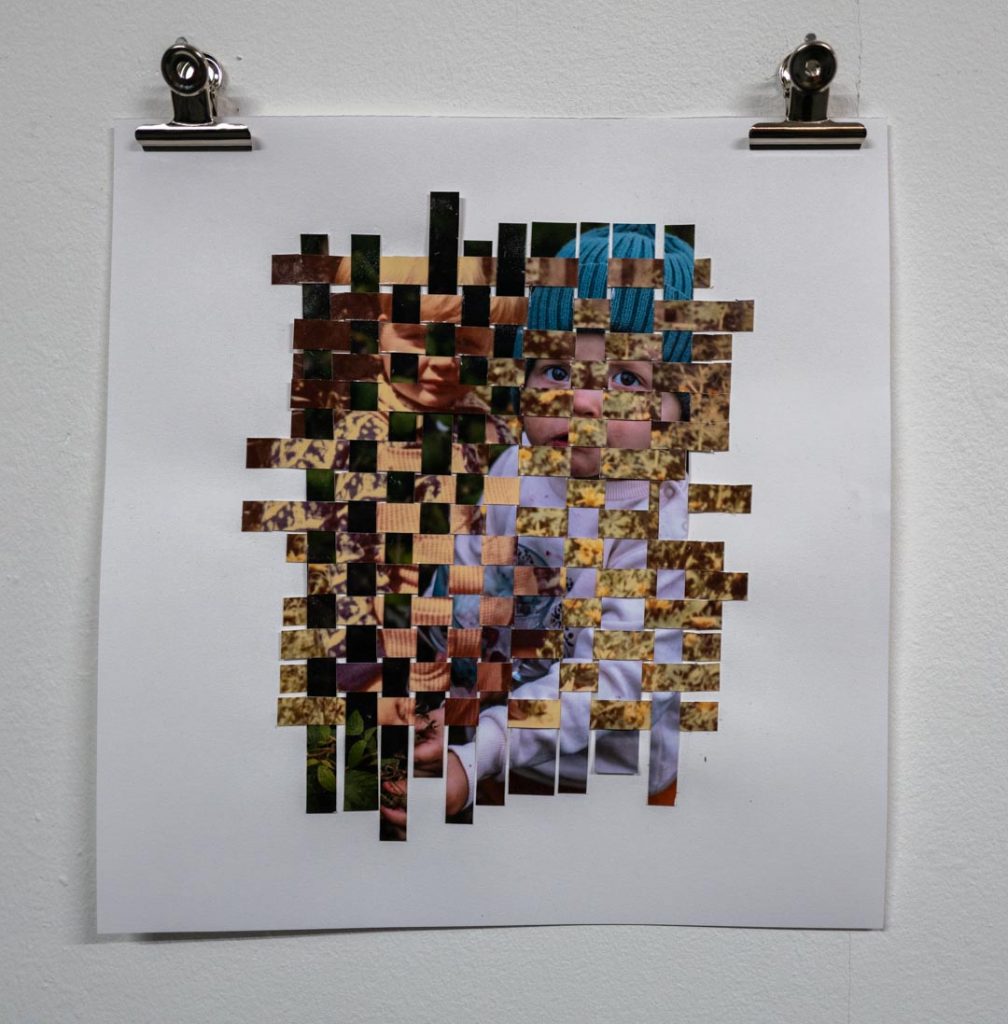
One of the methods of presenting images that caught my eye, and others was that there was a large image and a smaller image appearing overlapped on the wall. As if it was a map or engineering diagram with a callout to a magnified part of the scene. It worked well as a way of explaining the contents of the images but I found it to be a little messy and wouldn’t be tempted to try this myself.
There were also other images that had been hung using bulldog clips rather than being framed and I think that this took away some of the connectedness in the exhibition as a whole. It may have been by design to segregate parts of the show from others but I found it didn’t work for me.
The images in general though were well photographed and provided a good documentary style time capsule of the area and people within.
Walking
Post exhibitions we all went our separate ways but Ieva needed to get back to New Street Station and wasn’t overly confident about getting there safely from Digbeth so I walked with her from the Minerva Works back up to the Bullring before bidding her farewell and doing a 180 and heading right back where I’d come from.
My idea was to go and shoot some of the areas in and around Digbeth in the area of the Custard Factory, with all of the street art/graffiti on display. A short gallery of images is presented below.

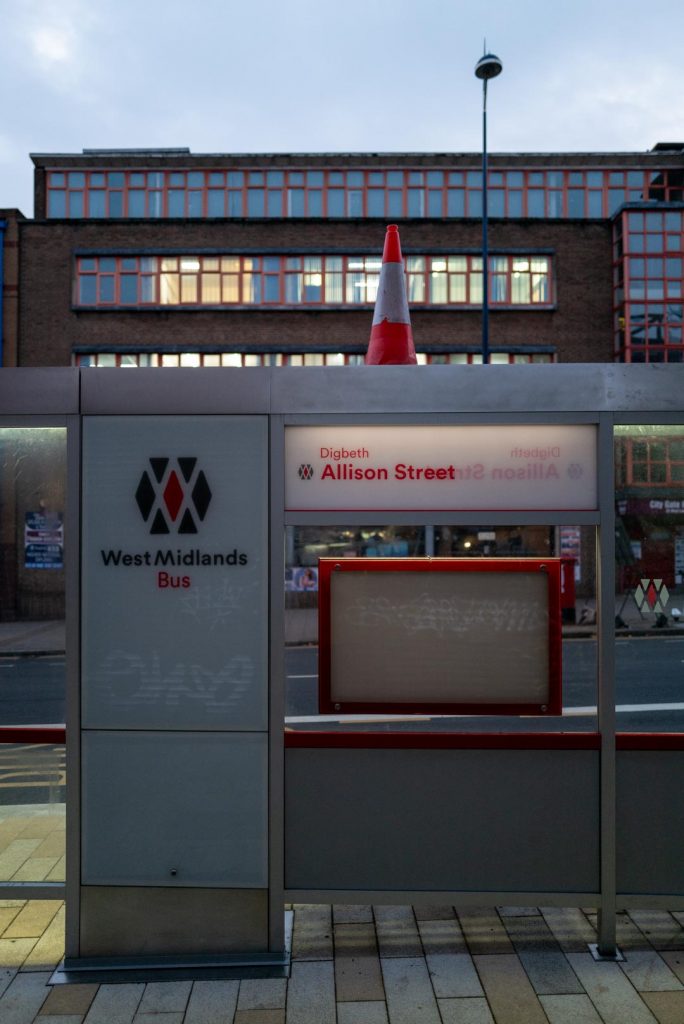

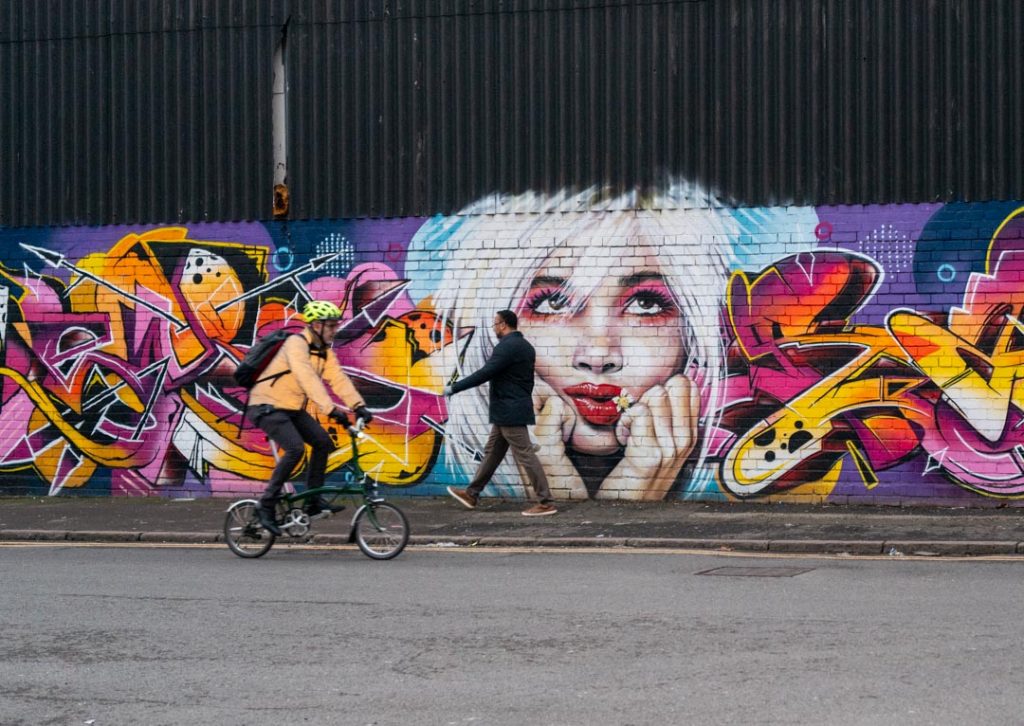

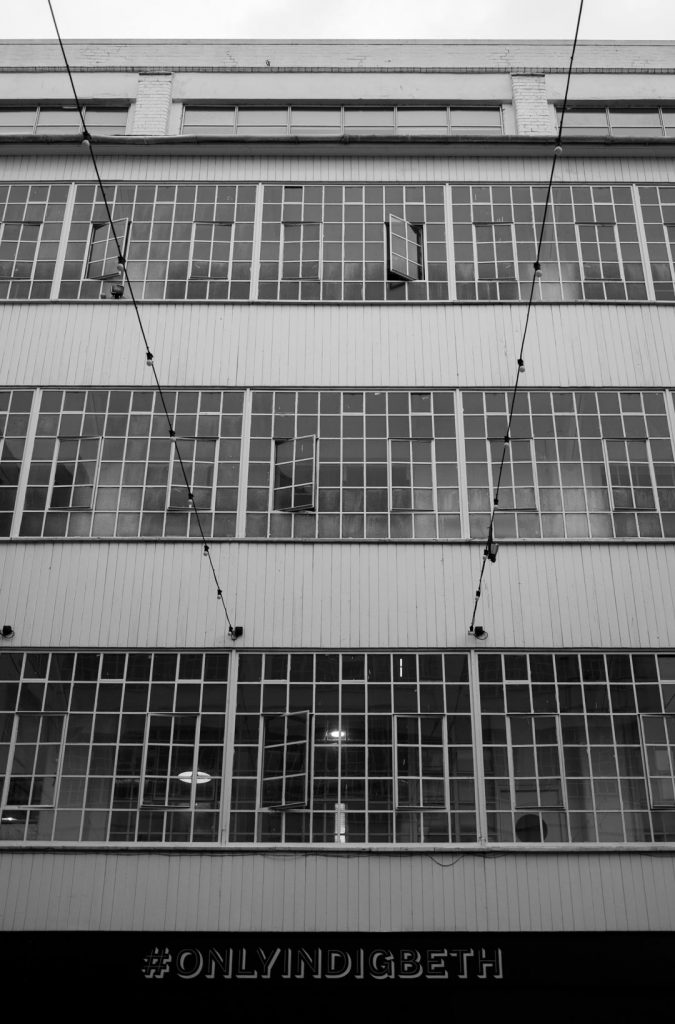
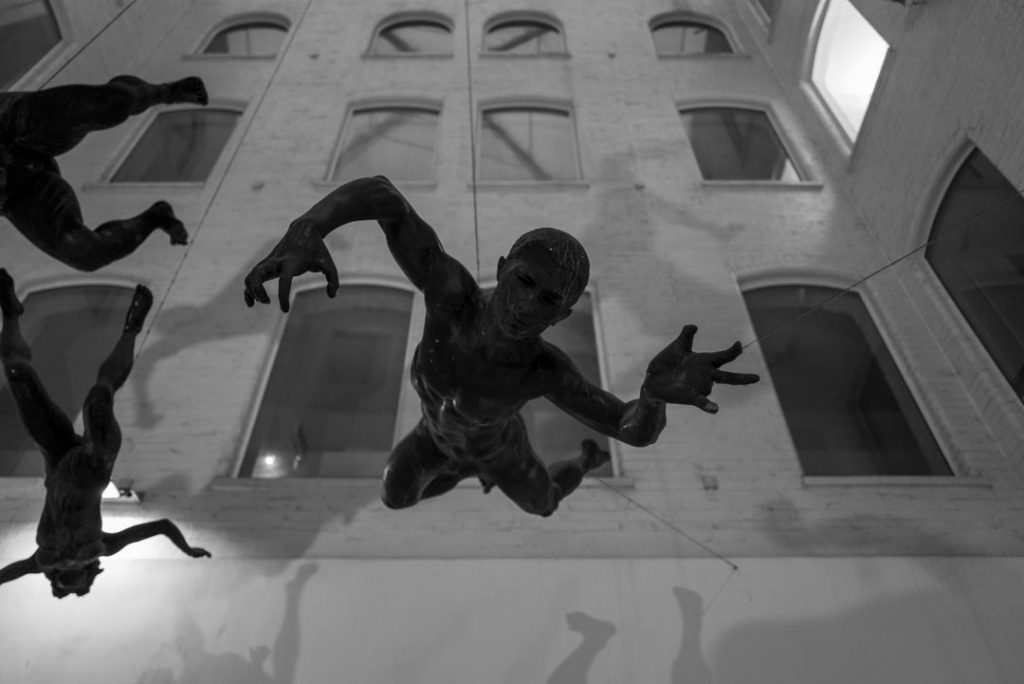
I had a look around in the Custard Factory and found EFA Gallery that was open and showing off some wonderful pieces of art by Mr J, they featured alternative movie posters such as Top Gun with Steve McQueen and others that I really liked. Each of the works were priced way outside of my league so I didn’t hang around long but did have a chat with Amy McLelland, Director of the gallery.

Back To The City
After a walk around Digbeth it was dropping dark so I headed back to the lights of the city so I could make some images of people enjoying the Frankfurt Market, and the associated beer and food that was on offer. There were plenty of opportunities for photos using the light around the city centre too as the whole area seemed to be lit by orange lights, adverts and shop windows.
I also had a ride on the big wheel in front of the library in Centenary Square, the view was cool too with a good view over the library and beyond.

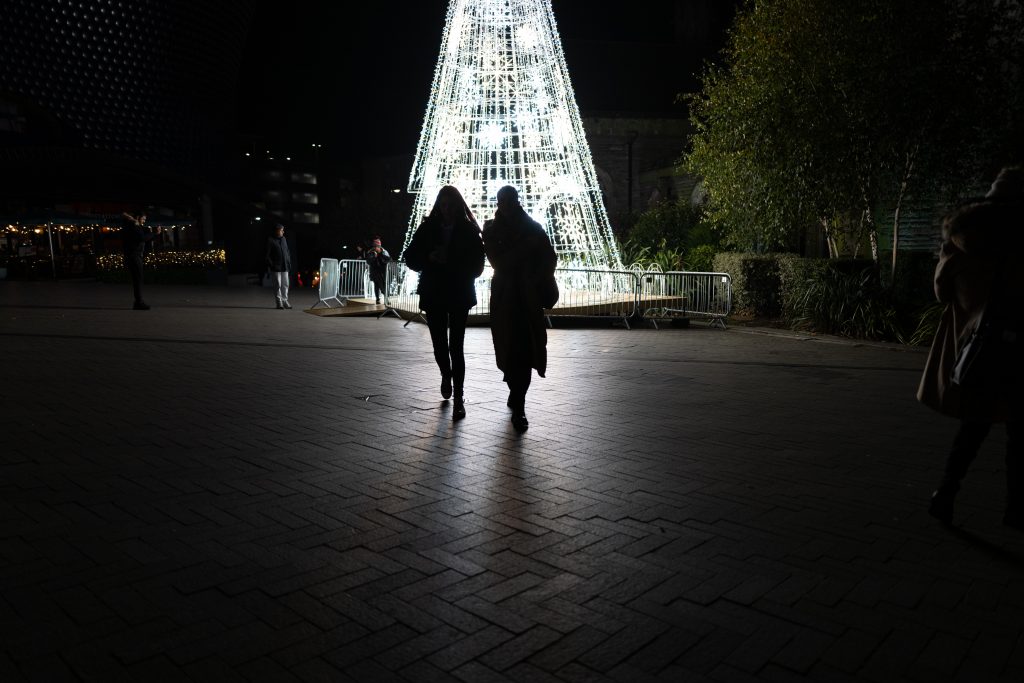
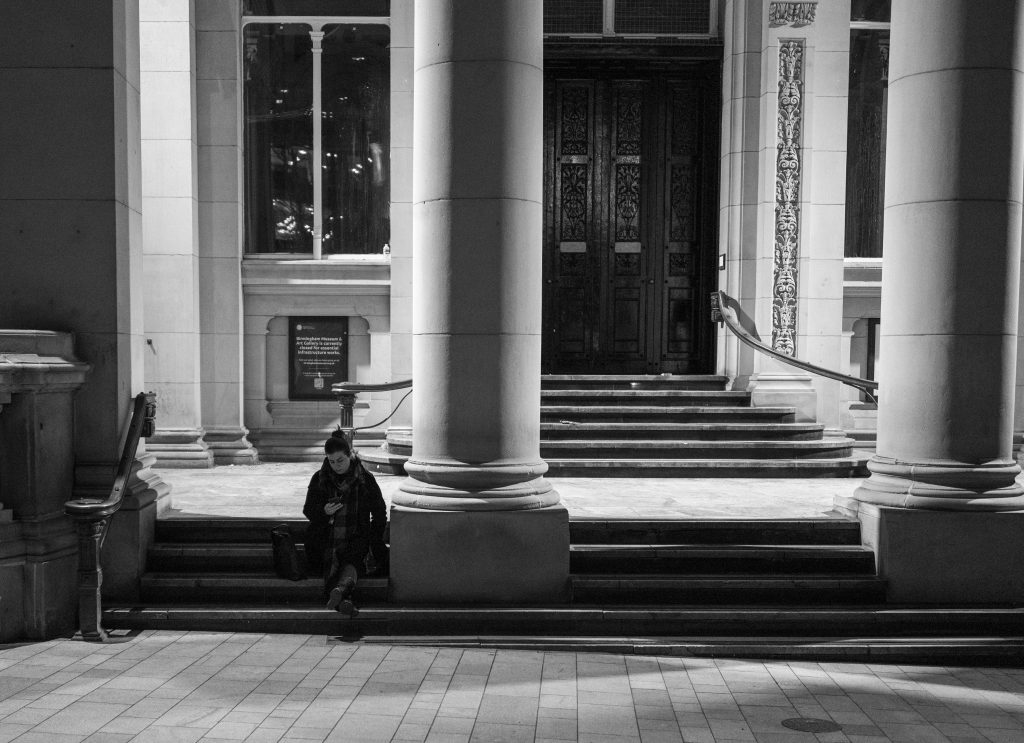
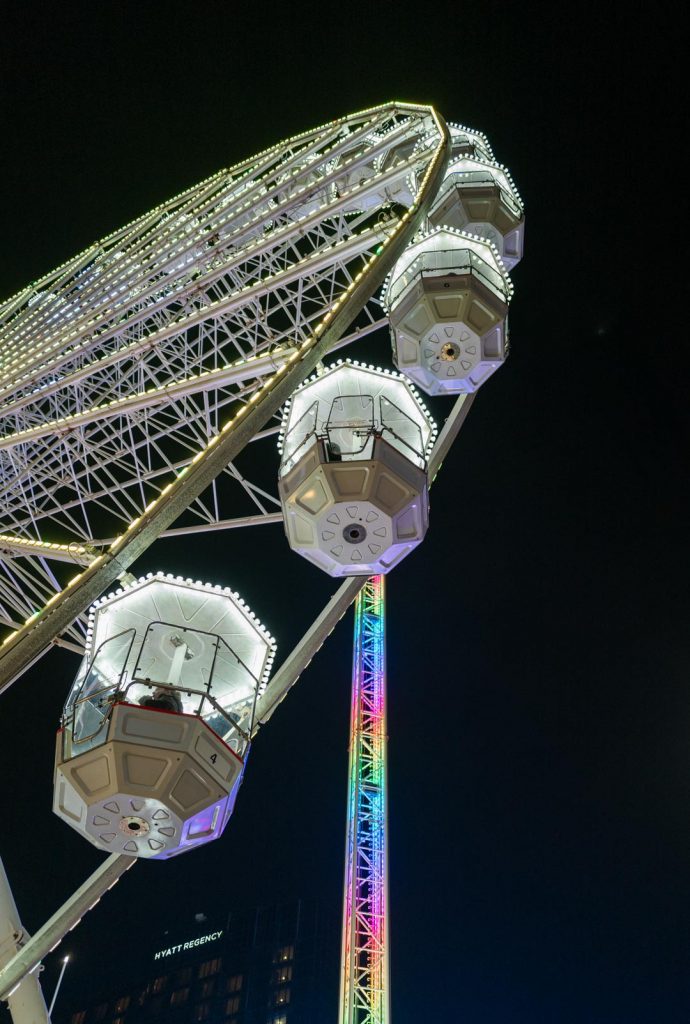
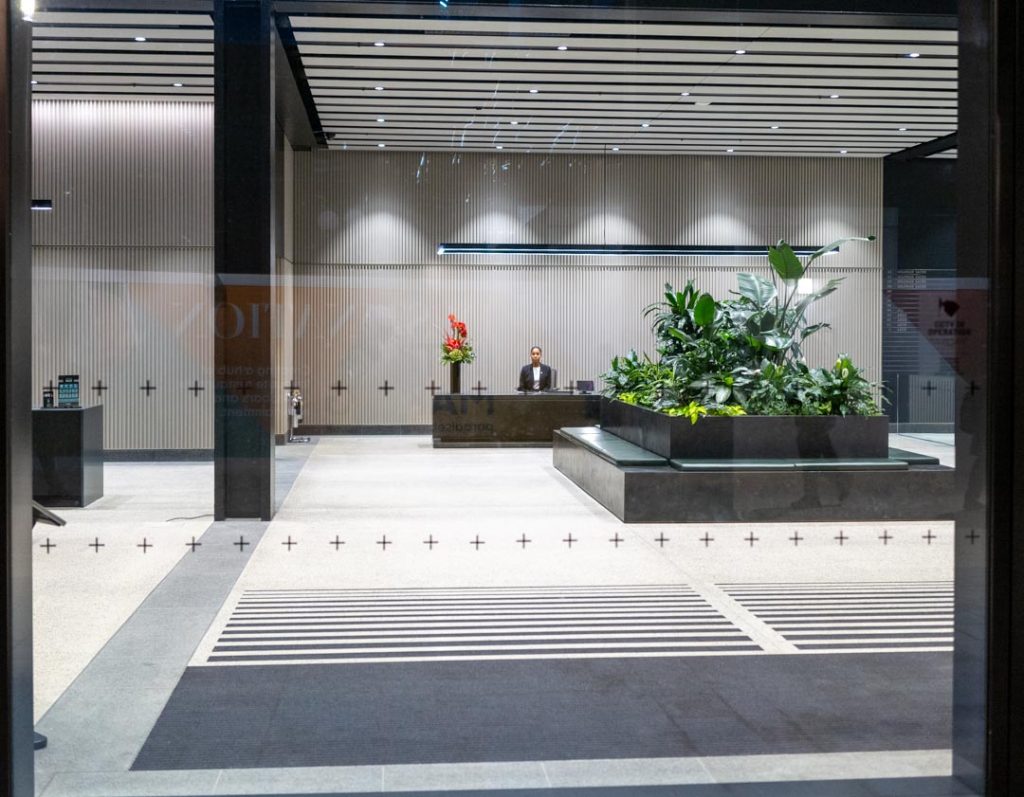
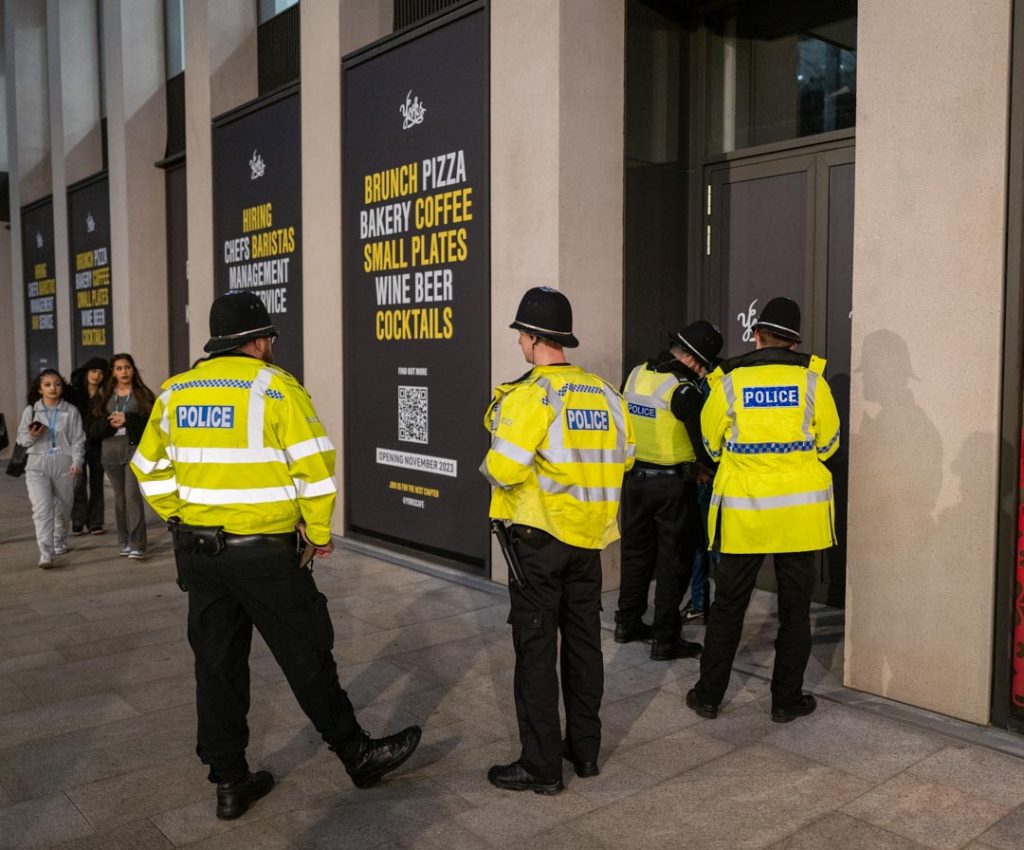

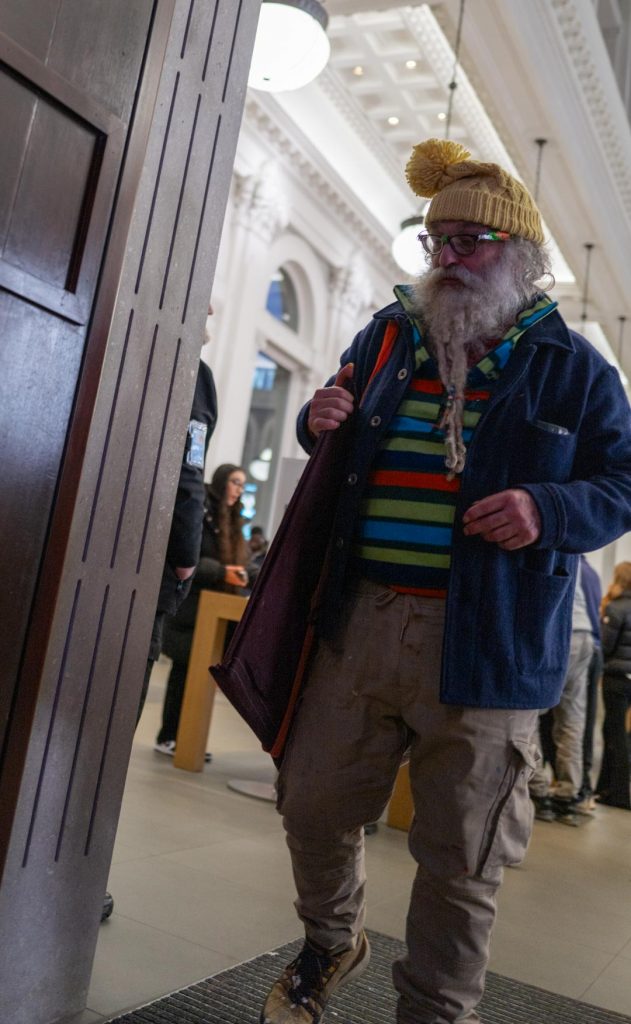

In Summary
20,000 steps or 10 miles later I wound up back at the Millenium Point car park ready for the hour long journey home and an evening of downloading images from the camera and making notes on everything that I’d seen,
The exhibitions we’d seen that day sparked off a number of questions in my mind about what I enjoy and what I don’t enjoy about viewing art in galleries. Some of the art I have trouble connecting with on any level, such as the work in the Eastside Projects gallery but it is easier for me to connect with the photography as we saw in the Centrala exhibition. I guess this just how I’m wired and that fine art students or artists might be more interested and connected to the physical works of art and sculpture. I spend a lot of time thinking about the technical challenges in making the art works, the drone footage of MacVoy for instance had me imagining the settings for the drone and Kelland’s videos were presented in different ways so I was trying to imagine how these were created.
It was a very worthwhile day out though, and I picked up some ideas about how I might present my work at our Easter exhibition. Considerations such as size, framing, material, locations, hanging methods, titles, artists statements, exhibition catalogue and how to talk about my art.
Thanks to Sylvia, Laura, Simon and Gavin for leading the visit and organising the opportunities to visit these unique spaces and exhibitions.
Next Tuesday it’s individual tutorials in the morning and seminars about Critical Thinking and Critical Texts so it’ll be interesting to talk to Sylvia about my practice in the morning and discuss where I am up to so far.
Be First to Comment